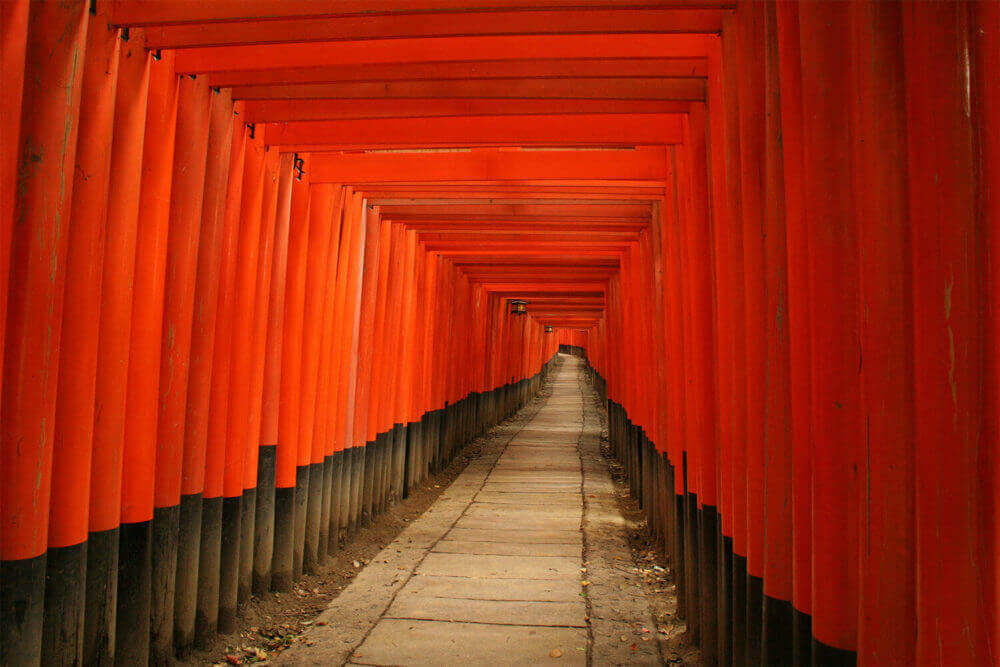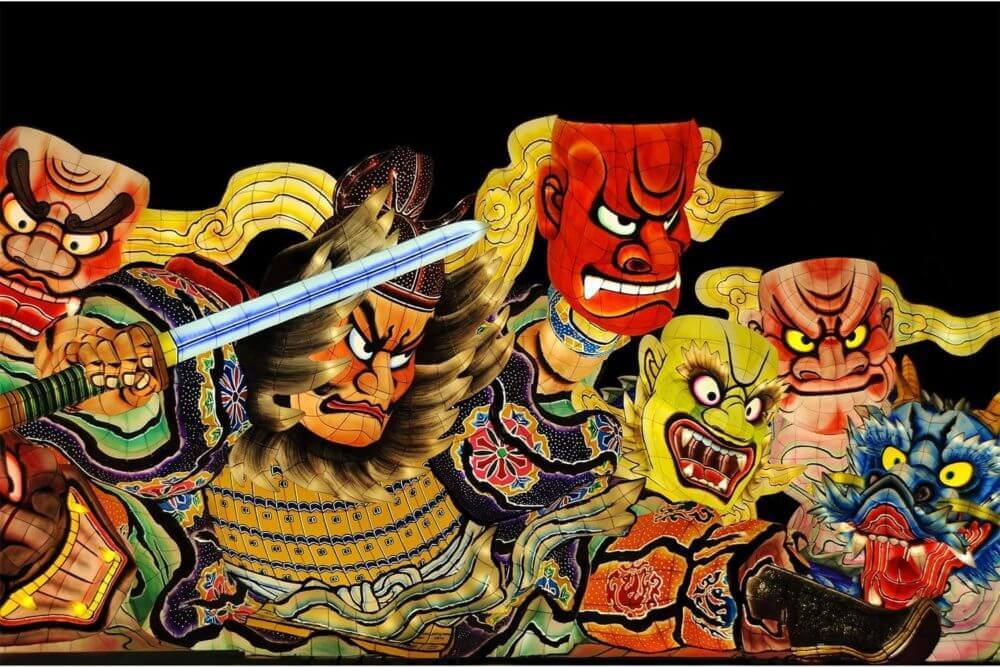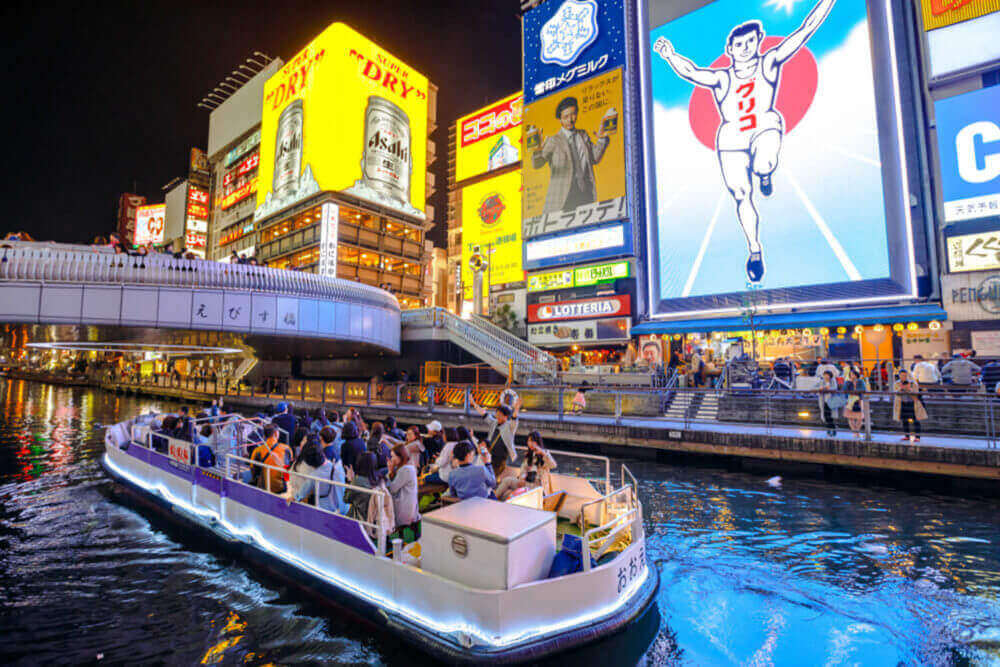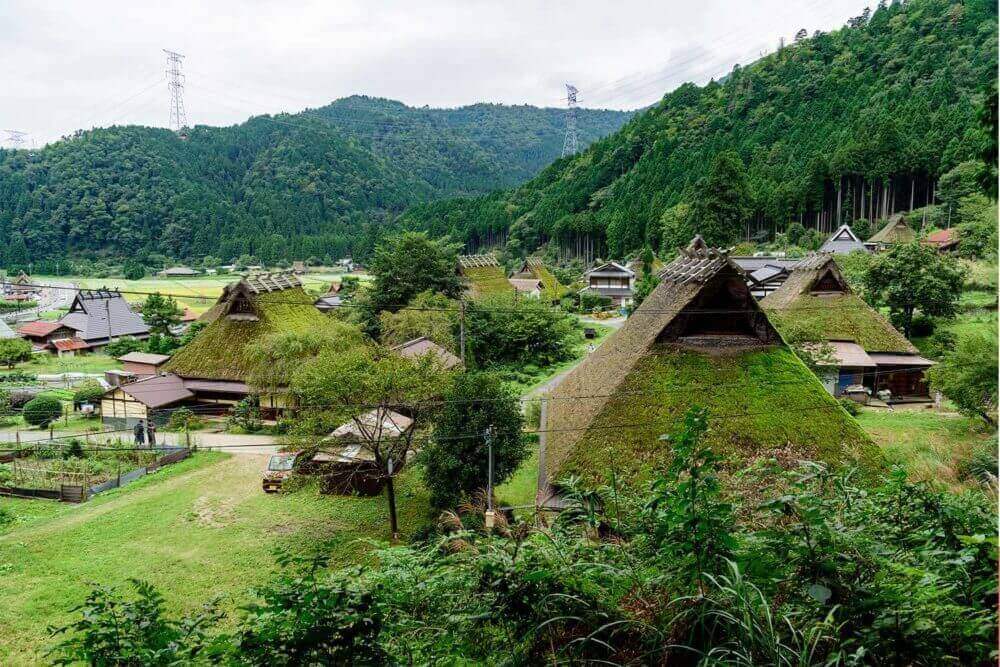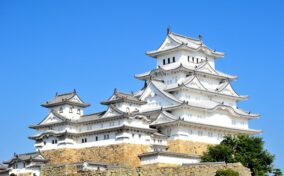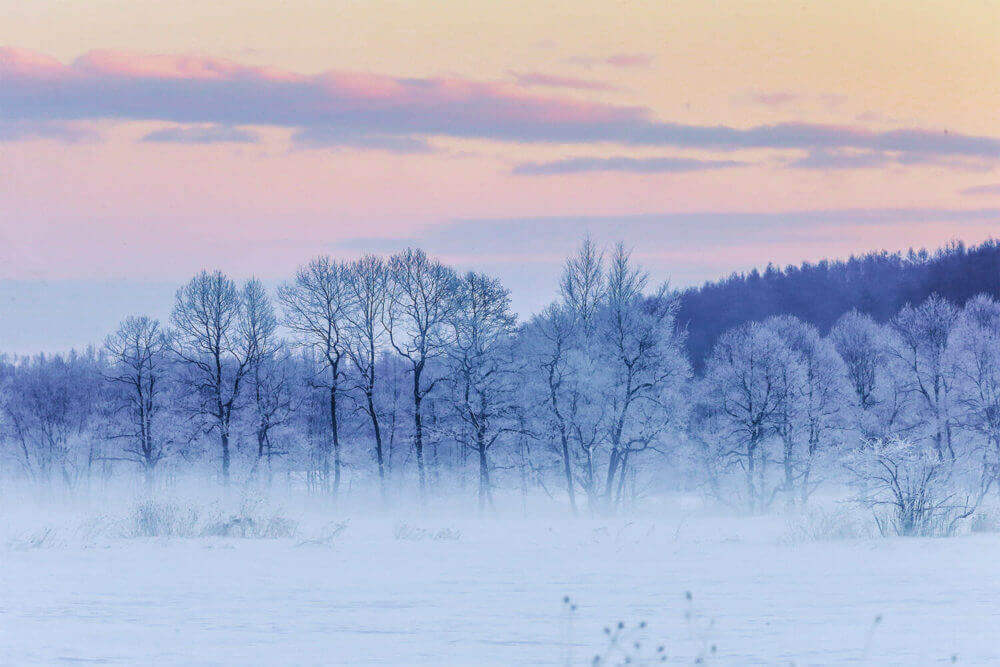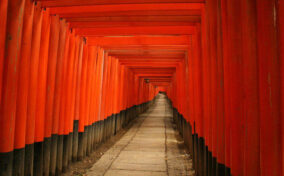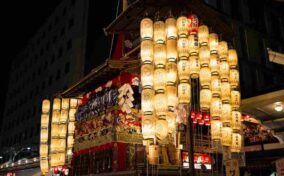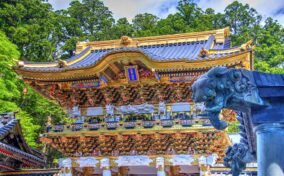Kyoto is a must-see when visiting Japan. Kyoto is a beautiful city that inherits traditional Japanese culture. If you go to Kyoto, you can fully enjoy traditional Japanese culture. There are many things to see and experience in Kyoto.
On this page, we will introduce spots in Kyoto that we especially recommend to tourists from overseas. It’s a long page, but if you read this page to the end, I think you’ll get the basic information you need for sightseeing in Kyoto.
Table of Contents
- Outline of Kyoto
- Weather in Kyoto
- Kyoto’s scenic photo page
- Kyoto Must see! ‘Fushimi Inari Taisha Shrine’
- Kyoto Must see! ‘Sanjusangendo’
- Kyoto Must see! ‘Kiyomizudera Temple’
- Kyoto Must see! ‘Kinkakuji Temple = Golden Pavilion’
- Kyoto Must see! ‘Ginkakuji Temple = Silver Pavilion’
- Kyoto Must see! ‘Philosopher’s Walk (Tetsugaku no Michi)’
- Kyoto Must see! ‘Eikando Zenrinji Temple’
- Kyoto Must see! ‘Nanzenji Temple’
- Kyoto Must see! ‘Yasaka Jinja Shrine’
- Kyoto Must see! ‘Gion’
- Kyoto Must see! ‘Kamogawa River’
- Kyoto Must see! ‘Pontocho district’
- Kyoto Must see! ‘Nishiki Market’
- Kyoto Must see! ‘Kodaiji Temple’
- Kyoto Must see! ‘Tofukuji Temple’
- Kyoto Must see! ‘Toji Temple’
- Kyoto Must see! ‘Byodoin Temple’
- Kyoto Must see! ‘Daitokuji Temple’
- Kyoto Must see! ‘Ryoanji Temple’
- Kyoto Must see! ‘Kyoto Imperial Palace (Kyoto Gosho)’
- Kyoto Must see! ‘Nijo Catsle’
- Kyoto Must see! ‘Katsura Rikyu’
- Kyoto Must see! ‘Arashiyama’
- Kyoto Must see! ‘Toei Kyoto Studio Park’
- Kyoto Must see! ‘Kifune Shrine’
Outline of Kyoto
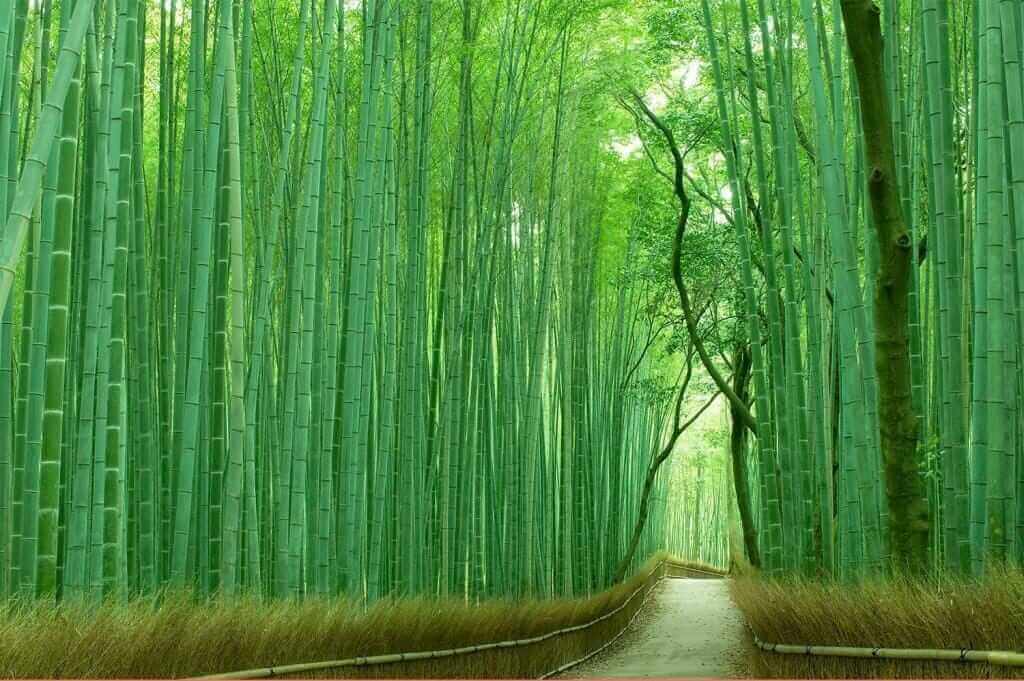
Beautiful Bamboo Grove in Arashiyama, Kyoto, Japan = Adobe Stock
>>Click here for Japan tour programs that include Kyoto in the itinerary!
Kyoto is a beautiful city 368 kilometers west of Tokyo. It is approximately 2 hours and 15 minutes by the fastest Shinkansen from Tokyo.
Kyoto was the capital of Japan for about 1000 years until the capital moved to Tokyo in 1869. Japan’s unique culture has been built in this city. Even today, there are many shrines and temples in Kyoto. There are also traditional wooden houses called “Kyo-Machiya” here and there. If you go to Gion etc, you will see beautifully dressed women, Maiko and Geiko.
When you visit the shrines and temples in Kyoto, you will be surprised that trees and streams in the garden are very beautiful. People in Kyoto have long loved nature. you can feel that.
Kyoto is located in a basin surrounded by mountains. And Gosho (the Imperial Palace) is located in the northern part of the basin, and the old streets are in good order. JR Kyoto Station is in the south. The famous shrines and temples are relatively close to the surrounding mountains. They are gathering especially near the mountain in the east called “Higashiyama”.
In Kyoto, a beautiful river “Kamogawa” flows from north to south. There is a bridge called “Shijo Ohashi” in the central part of Kyoto. The area around this bridge is the busiest downtown in Kyoto. In the immediate vicinity there is a Gion where still beautiful geisha (Geiko and Maiko) are walking.
Since Kyoto was a capital of Japan for 1000 years there are many temples and shrines that represent Japan. Furthermore, the streets of Kyoto had little damage during the Second World War, so the old towns surrounding the temple and the shrines and the life culture there also remained. In other words, Kyoto is a city like a theme park where you can meet old Japan. So, please visit the beautiful temples and shrines as below.
Regarding the most recommended temples and shrines in Japan, I wrote the following articles. When writing about sightseeing spots in Kyoto, there are many parts that duplicate the article by all means. I will inform you of the overlapping parts on this page by link on this page, so please refer to that page if you do not mind.
There are famous festivals from old times in Kyoto. I will introduce them on this page as well, but since there are many overlapping parts of the following articles on festivals in Japan, I will also link them individually.
There are many sights of autumn leaves in Kyoto. In this ancient capital, many beautiful Japanese gardens have been built for many years, and maple and other plants have been planted. Please refer to the following article about the sights of autumn leaves in Kyoto.
Weather in Kyoto
The weather in Kyoto City is almost the same as that of other mainland Japan cities such as Tokyo and Osaka. However, since Kyoto City is located in a basin, it is characterized by hot summers and cold winters. The best time to visit Kyoto is from late March to late May, when the cherry blossoms and fresh greenery are beautiful, and from early October to early December, when there are many sunny days. The peak of the autumn foliage season is from late November to early December. However, since all tourist attractions are extremely crowded during these peak tourist seasons, it is wise to travel at other times of the year.
Monthly weather in Kyoto
Below are articles about the weather in Kyoto. Click on the month of interest to see articles about that month.
| January | February | March |
| April | May | June |
| July | August | September |
| October | November | December |
Kyoto’s scenic photo page
And more
>> Photos: Kamogawa River in Kyoto
>> Photos: Nanzenji Temple in Kyoto
>> Photos: Daitokuji Temple -The World of Zen in Harmony with Nature
>> Photos: Kodaiji Temple in Kyoto
>> Photos: Kyoto Imperial Palace (Kyoto Gosho)
>> Photos: Cherry blossoms in Kyoto
>> Photos: Traditional Kyoto in Summer
>> Photos: The Jidai Matsuri Festival
>> Photos: Autumn colors at Tofukuji Temple, Kyoto
>> Photos: The fantastic illumination “Hanatouro” in Arashiyama, Kyoto
Kyoto Must see! ‘Fushimi Inari Taisha Shrine’
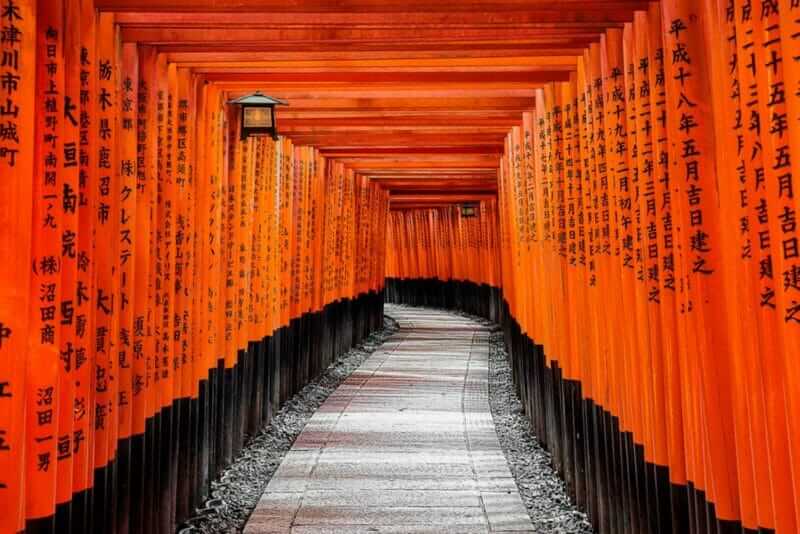
Red Torii gates in Fushimi Inari Taisha shrine in Kyoto, Japan = shutterstock
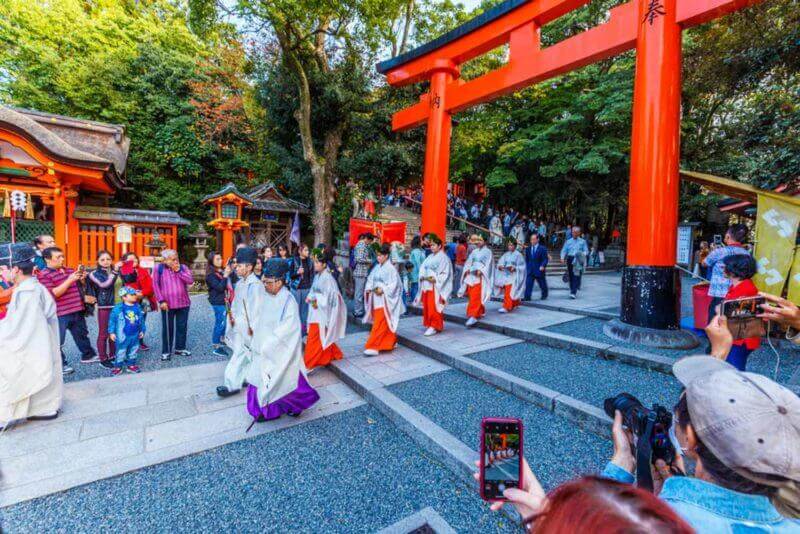
Fushimi Inari Taisha Shrine located in Southern Kyoto, Japan = Shutterstock
Fushimi Inari Shrine was listed among the top attractions for international tourists visiting Japan. This shrine has about 10,000 red torii gates. While walking under these mysterious red gates, visitors enter the mysterious world.
This shrine is located in the southeast of Kyoto city. The nearest stations are JR Inari station and Fushimi-Inari station of Keihan line. If you get off at JR Inari Shrine, the approach is continuing from the station to Fushimi Inari. If you get off at Fushimi Inari shrine in Keihan, Fushimi Inari is about 5 minutes.
To Fushimi Inari Shrine, so many people visit on holidays. If you want to spend a quiet time at this shrine, I would recommend going on weekdays.
>> Photos: Fushimi Inari Taisha Shrine in Kyoto
>> For details about Fushimi Inari Taisha Shrine, please click here
>>Find the best deal, compare prices, and read what other travelers have to say at Tripadvisor!
Kyoto Must see! ‘Sanjusangendo’
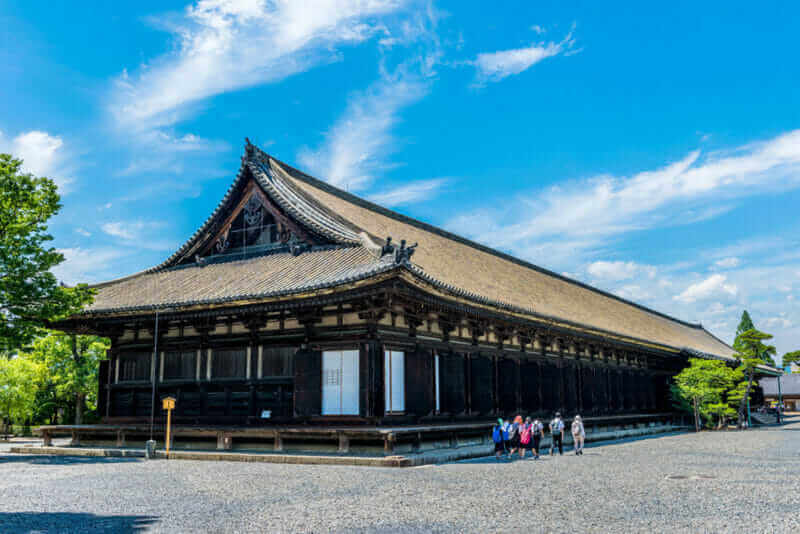
Sanjusangendo in Kyoto city, Japan = shutterstock
Sanjusangendo is a long Buddhist temple hall 120 meters north and south as seen in the picture above. Such a long wooden building is very rare in the world.
This long temple hall was built for Emperor Go-Shirakawa in 1164 by Taira-no-Kiyomori who was then the powerful person. At that time it was part of a huge temple. The temple was destroyed in 1249 due to a fire. And in 1266 only this hall was rebuilt.
This long temple hall has 1001 statues of Kannon, the goddess of mercy. The sight that those Buddha statues line up is a masterpiece.
“Sanjusangen” means “33 intervals” in Japanese. This comes from 33 number of intervals between the building’s support columns. In short, this name indicates that it is such a long temple hall.
In this temple, archery competitions have been held for a long time. At the side of the temple hall, it was competed how many arrows could be placed about 120 meters away. Today every year, a competition is held with a 60 meter venue near the temple hall.
There are two ways to access Sanjusangendo. (1) 10 minutes by city bus from JR Kyoto Station (100 · 206 · 208 strains, Just Near “Hakubutsukan-Sanjusangendo-mae (Museum Sanjusangendo)”. (2) 7 minutes on foot from Keihan Shichijo Station.
>>Find the best deal, compare prices, and read what other travelers have to say at Tripadvisor!
>>Please click here for the tour program of Fushimi Inari and Sanjusangendo.
Kyoto Must see! ‘Kiyomizudera Temple’

Kiyomizu-dera Temple in Kyoto Japan = shutterstock
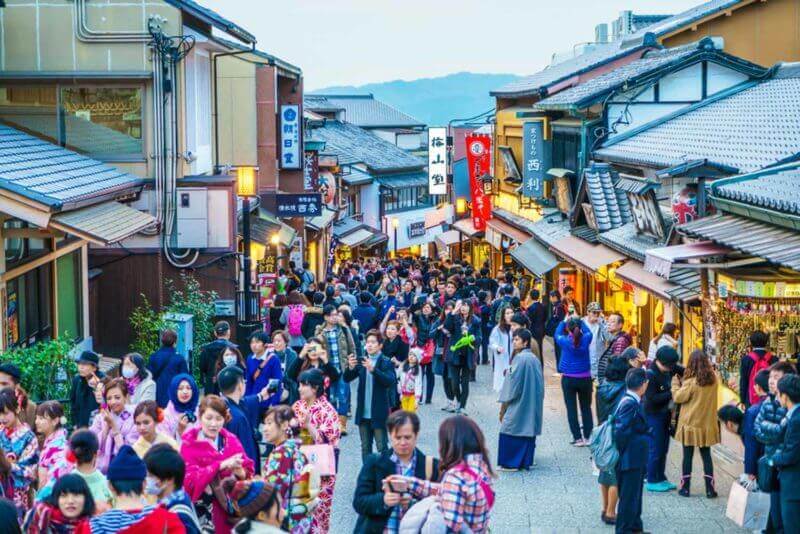
Japanese traditional shopping street, Kiyomizuzaka in Kyoto, Japan = shutterstock
Kiyomizudera Temple is one of the most celebrated temples in Kyoto. This temple spreads in the mountains of the eastern part of Kyoto city. The main hall is built on a cliff as seen in the picture above. From the wooden stage that juts out from the main hall called “Kiyomizu-no-Butai”, you can see the whole city of Kyoto. Under this stage of height 18 meters, you can see the beautiful autumn leaves from around late November to the beginning of December.
To Kiyomizudera Temple, take a bus of 206 and 100 lines from Kyoto Station and get off at “Kiyomizu-michi”. It is an 8-minute walk from there.
If you use a train, it is about 20 minutes on foot from Keihan train’s Kiyomizu-Gojo station to Kiyomizudera Temple. A lot of souvenir shops and street food stores are lined up on the slope (Kiyomizu-zaka) about 1 km to Kiyomizudera Temple. It is fun to take a walk while visiting those shops.
>> Photos: The historic hill roads in Kyoto -Sannei-zaka, Ninei-zaka, etc.
>> For details about Kiyomizudera Temple, please click here
>>Find the best deal, compare prices, and read what other travelers have to say at Tripadvisor!
Kyoto Must see! ‘Kinkakuji Temple = Golden Pavilion’
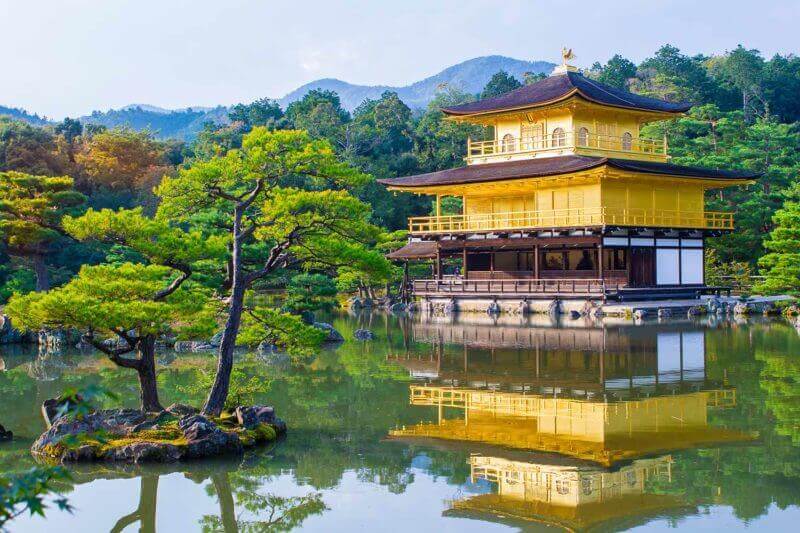
Kinkaku-ji, the Golden Pavilion, a Zen Buddhist temple in Kyoto, Japan = shutterstock
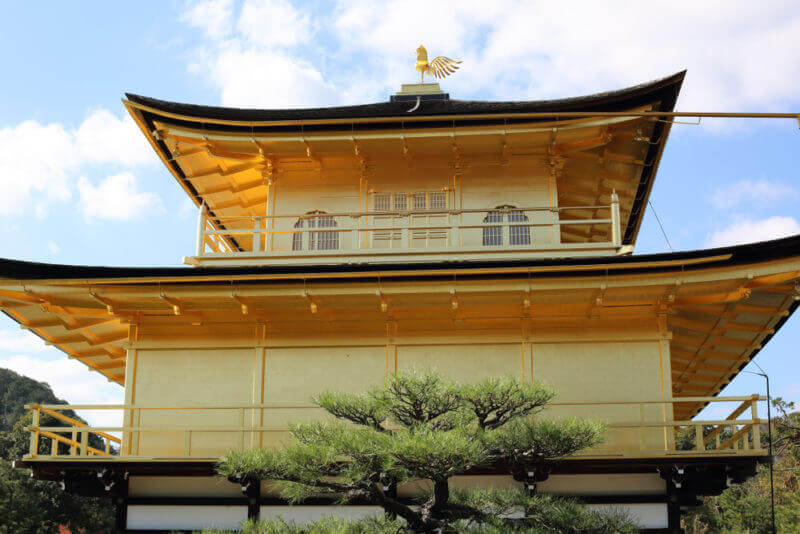
Kinkakuji Temple in Kyoto, Japan = shutterstock
If you ask the Japanese for a temple representing Japan, many Japanese will first mention Kinkakuji Temple. Kinkakuji is such a famous temple.
This temple has the Golden Pavilion completely covered with gilt. If you look at the Golden Pavilion at the back of a beautiful pond, you will definitely want to take a picture. This Golden Pavilion has a superb beauty. Even those who have seen this Golden Pavilion already with many photos, he loses his words to that much beauty when actually seeing this building.
Kinkakuji is a little northern part of Kyoto city. If you are going to Kinkakuji by bus from JR Kyoto Station, you may get on the bus of 101 or 205 lines and get off at “Kinakuji-michi”. It is a 10-minute walk from this bus stop to Kinkakuji.
If you go to Kinkakuji during the crowded period such as November, the road in Kyoto city is at risk of traffic jam. In such a case, please go to Kitaoji Station by subway Karasuma line. To Kinkakuji, take a bus such as 101 lines, 102 lines or 205 lines from Kitaoji Bus Terminal and get off at Kinkakuji-michi.
>> Photos: Kinkakuji vs Ginkakuji -Which is your favorite?
>> For details about Kinkakuji Temple, please click here
>>Find the best deal, compare prices, and read what other travelers have to say at Tripadvisor!
Kyoto Must see! ‘Ginkakuji Temple = Silver Pavilion’
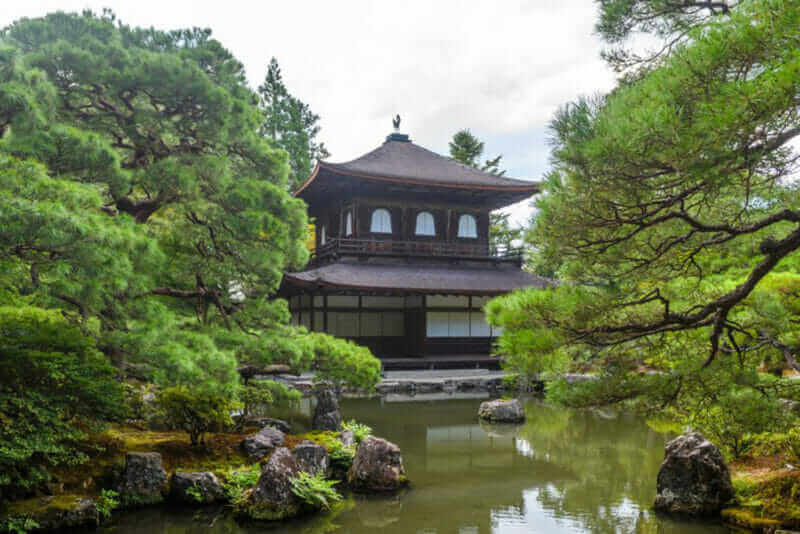
Beautiful Ginkakuji Temple at Higashiyama district, Kyoto = shutterstock
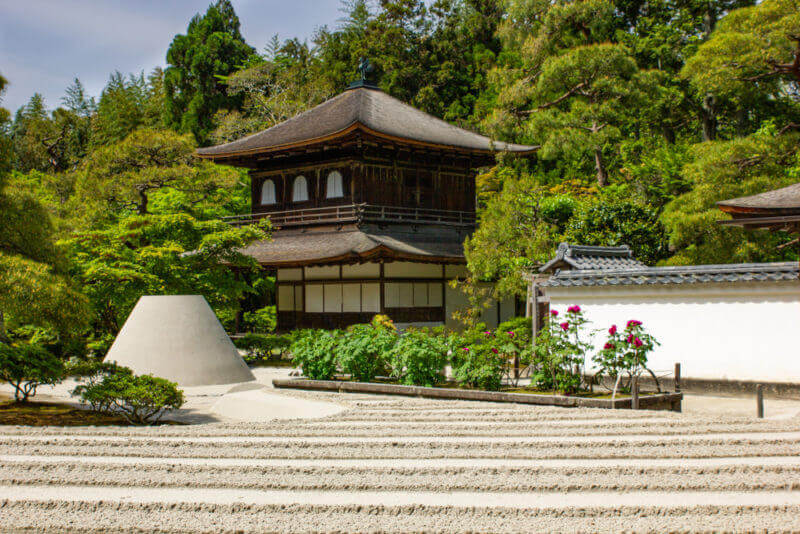
Ginkakuji is a very famous temple located in the northeastern part of Kyoto city.
The official name of this temple is Jishoji Temple, but this temple is contrasted with Kinkakuji (Golden Pavilion) and is called Ginkakuji (meaning Silver Pavilion in Japanese).
If Kinkakuji is the sun, it can be said that Ginkakuji is the moon.
Ginkakuji was built by Yoshimasa ASHIKAGA who was shogun of Muromachi shogunate in 1482. Yoshimasa is said to have built this building with reference to Kinakuji. This building was originally his villa. Based on this villa he interacted with many monks and aristocrats, and created the culture based on Zen called “Higashiyama culture”.
While the Kinkakuji is spectacular, Ginkakuji is based on Zen and is very simple.
In Kinkakuji, the building is the protagonist. In contrast, buildings are not central in Ginkakuji.
In Ginkakuji, in addition to the building, the surrounding gardens and trees are very beautiful.
There is a white sandy garden in Ginkakuji as shown in the picture above. In the era of Yoshimasa the night was pitch black. However, it is said that the garden shone by the moonlight, and the building was illuminated on a bright night.
In the surroundings of the building there is a forest where beautiful moss grew. This moss is also not gaudy but it attracts visitors with its deep beauty.
The building of Ginkakuji is called “Silver Pavilion”, but the building is not stuck with silver foil. This temple began to be called “silver pavilion” since the Tokugawa shogunate era. As this temple is often contrasted with the Kinkakuji (Golden Pavilion), it came to be called like this.
>> Photos: Kinkakuji vs Ginkakuji -Which is your favorite?
>>Find the best deal, compare prices, and read what other travelers have to say at Tripadvisor!
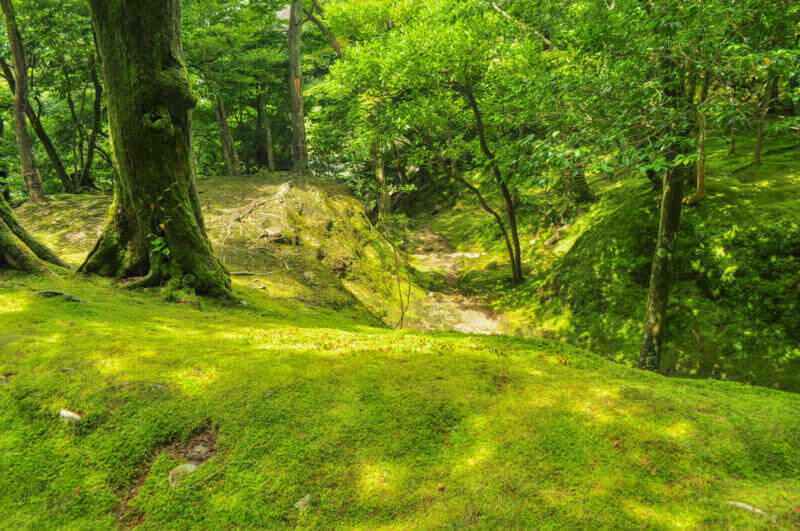
The green, moss garden placed around GInkakuji temple (Silver Pavilion) in Kyoto i Japan. Lot of green leaves, moss and water make beautiful and magnificent scenery = shutterstock
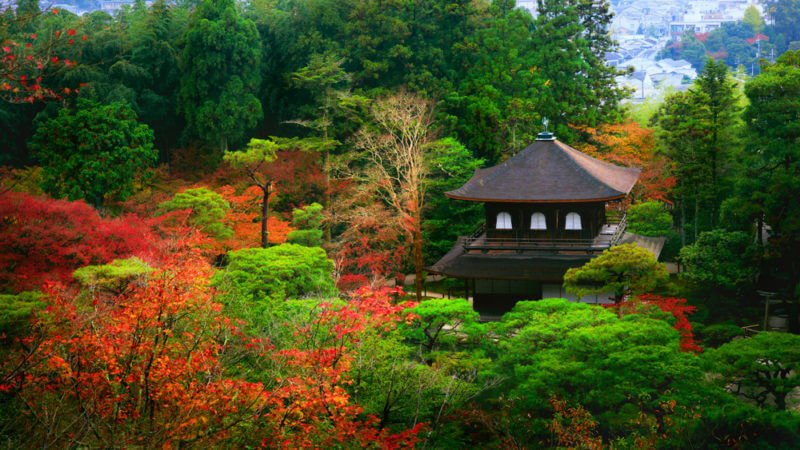
Beautiful autumn leaves at Ginkakuji Temple, Kyoto Japan = shutterstock
Kyoto Must see! ‘Philosopher’s Walk (Tetsugaku no Michi)’

Philosopher’s Walk in the spring season
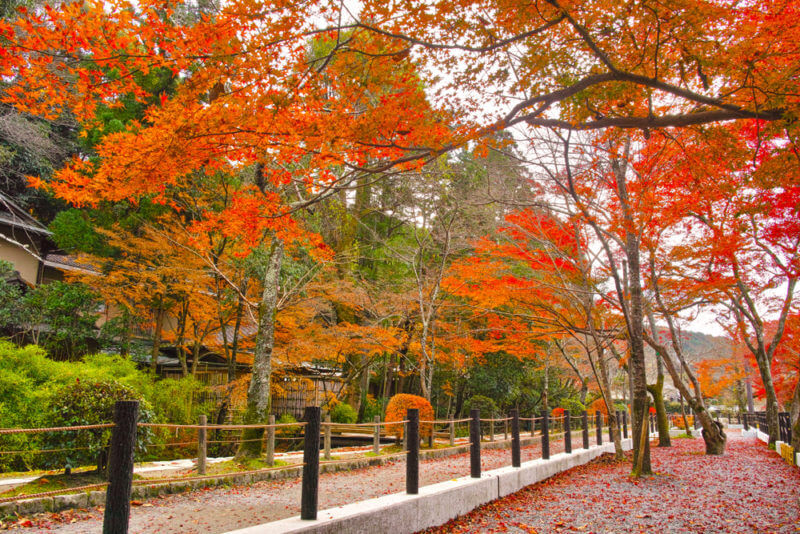
Kyoto in autumn leaves season, view from the Tetsugaku no Michi (Philosopher’s Walk) in the morning = shutterstock
Philosopher’s Walk (Tetsugaku no Michi) is a very popular walking path that lasts about 2 kilometers north and south in the eastern part of Kyoto city. It starts in the north near Ginkakuji and continues to near Eikan-do, to be described later. You can walk this trail in approximately 30-40 minutes.At the side of Philosopher’s Walk there is a beautiful waterway called “Lake Biwa Canal”. This waterway was built more than 100 years ago to draw water from Lake Biwa in the east of Kyoto City into Kyoto city. There are many trees around the waterway. So in the spring, cherry blossoms are blooming, leaves grow from spring to summer, and in autumn they become red and yellow.
Because this trail is quiet, everyone walking around here will calm down. It is said that Kitaro NISHIDA, a philosopher who was a professor at Kyoto University in the first half of the 20th century, thought in this path. He was a leading philosopher in Japan. Later, his disciples came to take a walk on this path as well. For this reason, this path gradually began to be called “Philosopher’s Walk”.
I often walk this path when I go to Kyoto. After feeling the world of Zen at Ginkakuji Temple, it is recommended that you stroll through Philosopher’s Walk quietly, heading to Eikan-do and Nanzenji Temple which is ahead. Philosopher’s Walk has fancy cafes, so it would be fun to stop by them.
If you want to see a detailed map of Philosopher’s Walk, the map on the official website below is recommended. When you click the following, the page with the map is displayed. The map is at the bottom of the page. It is written in Japanese, but since it is accompanied by English, you can understand.
>>Find the best deal, compare prices, and read what other travelers have to say at Tripadvisor!
Kyoto Must see! ‘Eikando Zenrinji Temple’
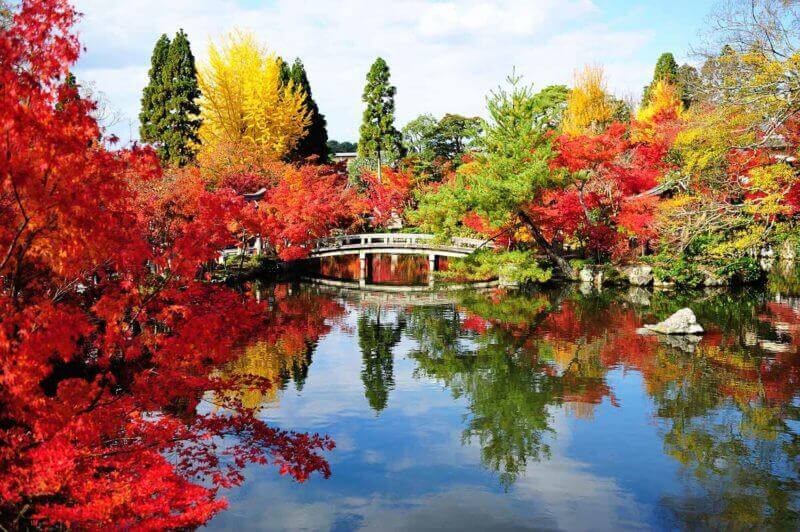
Eikando Temple which is said to be the most beautiful autumn leaves in Kyoto = AdobeStock

Traditional zen garden in spring season. Eikan-do Temple or Zenrin-ji belongs to the Jodo sect of Japanese Buddhism. Eikando is a popular landmark and Zen Temple in Kyoto, Japan = shutterstock
If you stroll from Ginkakuji Temple through Philosopher’s Walk for about 30 minutes, you will arrive near Eikando Zenrinji Temple. You may go to Nanzenji in this way, but if you are going to sightsee in fall or spring fresh green season, I recommend you go to Eikando.
Approximately 3000 maples are planted in Eikando. Every year, during the fresh green season from April to May, those maples create delicate and beautiful scenery. Furthermore, they create an overwhelming beautiful autumnal leaves world from late November to early December.
It has been said that Eikando is the most beautiful autumn leaves in Kyoto since ancient times. I would like you to enjoy the scenery as well.
Regarding Eikando, I introduced in the articles on autumn leaves below. If you do not mind, please read these articles as well.
>>Find the best deal, compare prices, and read what other travelers have to say at Tripadvisor!
Kyoto Must see! ‘Nanzenji Temple’
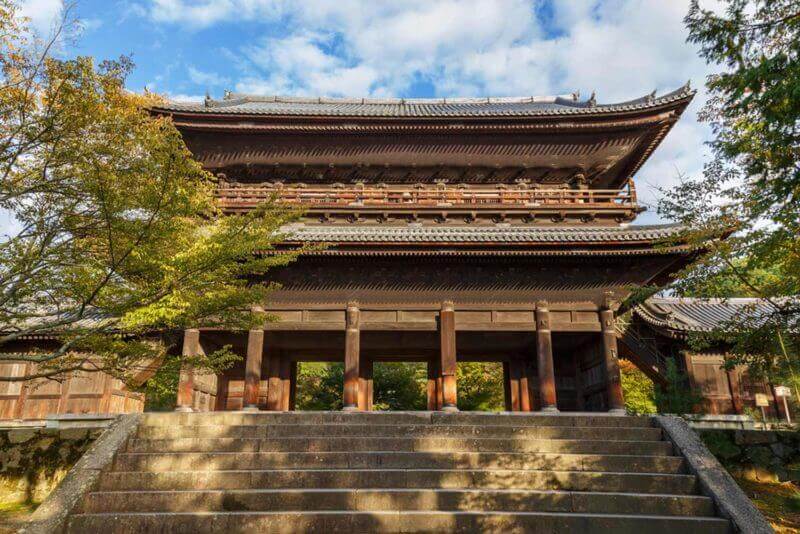
Sanmon Gate at Nanzenji Temple in Kyoto, Japan = shutterstock
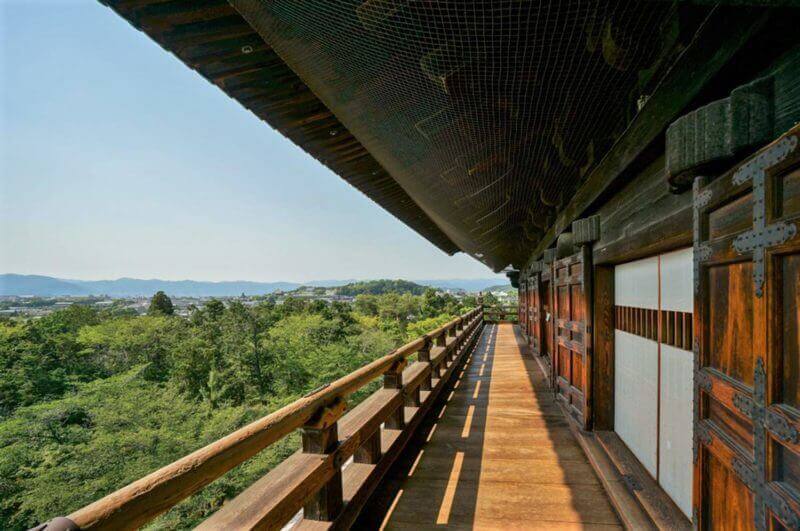
View from Second Story of Sanmon Gate of Nanzenji Temple in Kyoto, Japan = shutterstock
Nanzenji is a big temple representing the Zen temple in Japan. In Japan, there are five top Zen temples in Kyoto and five top Zen temples in Kamakura, but Nanzenji is positioned further above them.
Nanzenji was founded in 1291. After that, many buildings were destroyed by fire several times, but since the 17th century the current building group has been improved under the support of the Tokugawa shogunate.
People who visit Nanzenji will first realize that Nanzenji is an authoritative temple when looking up at the huge Sanmon (main gate). This Sanmon has a height of 22 meters. The current Sanmon was rebuilt in 1628. You can climb the second floor (the observation floor) of this gate. From there, you can see the whole city of Kyoto as seen in the picture above. However, please be careful as wooden old staircase is a quick slope.
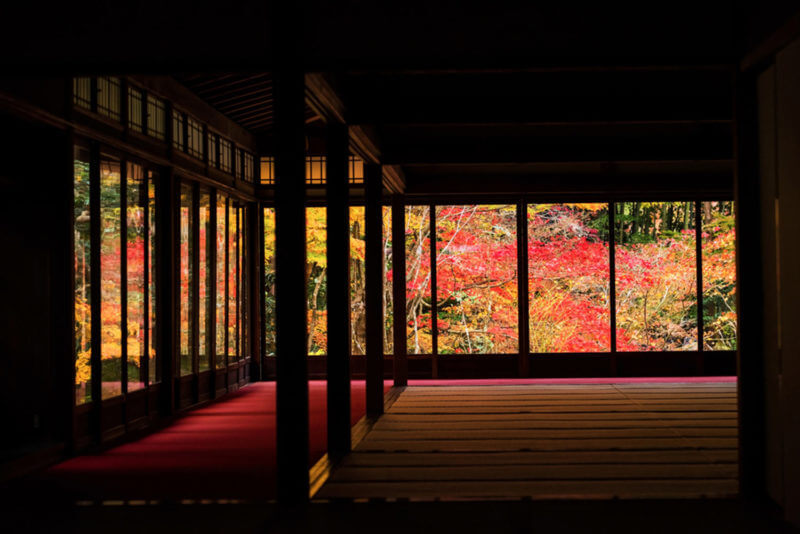
Autumn colors surround the building of Tenju-an or Tenjuan Temple near Nanzenji temple, Kyoto, Japan = shutterstock
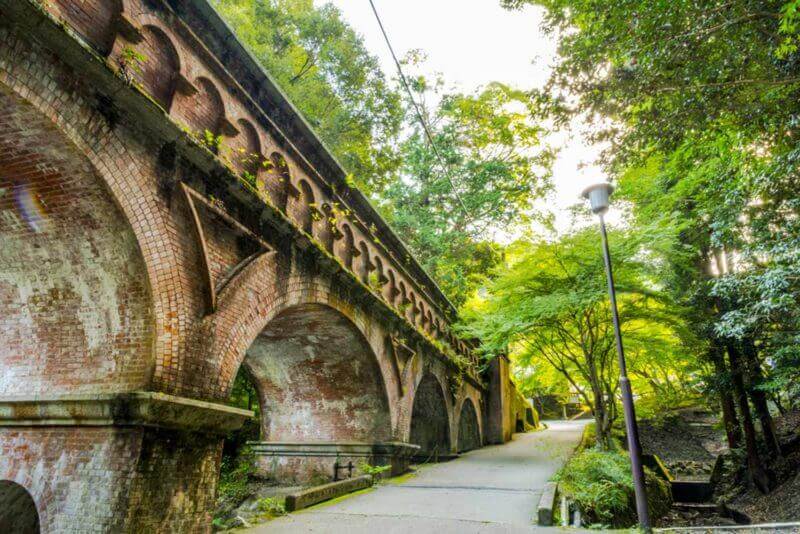
Suirokaku Waterway in Nanzenji temple, Kyoto, Japan = shutterstock
The premises of Nanzenji are about 150,000 square meters. In addition to the central hall Hojo (national treasure), there are also many sub-temples and others. Nanzenji can be said to be a large complex.
There are several Zen gardens in the Central Hall.
In the sub-temple called Tenjuan, you can see beautiful trees through Japanese traditional buildings, as seen in the photo above. Fresh green in spring and autumn leaves in autumn are as wonderful as paintings.
There is a red brick building called “Suirokaku” inside the temple of Nanzenji, as seen in the above picture. This arched building was built in 1890. A waterway called “Lake Biwa Canal” runs through this building. This waterway was built more than 100 years ago to draw water from Lake Biwa into Kyoto city. There were many objections from those who cherish the tradition about the construction of this building, but now it is one of the popular attractions in Nanzenji.
Nanzenji is a 10-minute walk from Keage Station on the subway Tozai line.
>>Find the best deal, compare prices, and read what other travelers have to say at Tripadvisor!
Kyoto Must see! ‘Yasaka Jinja Shrine’
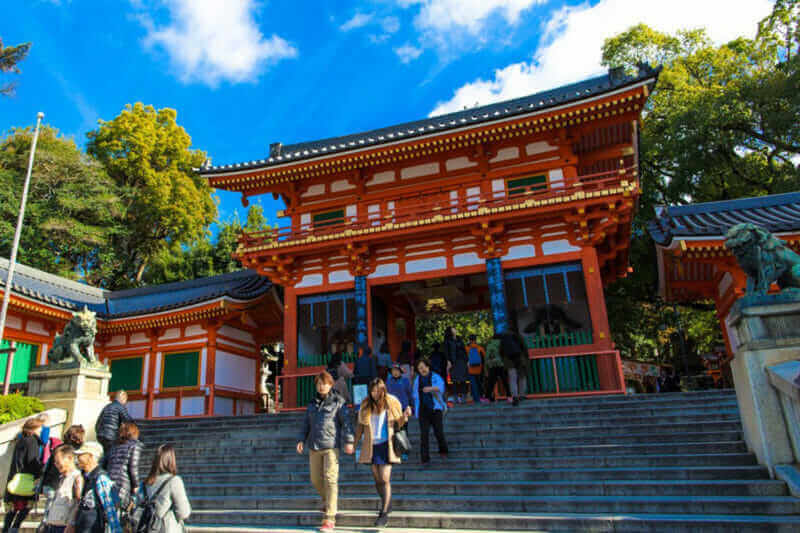
Yasaka Jinja shrine of Kyoto, Japan = shutterstock
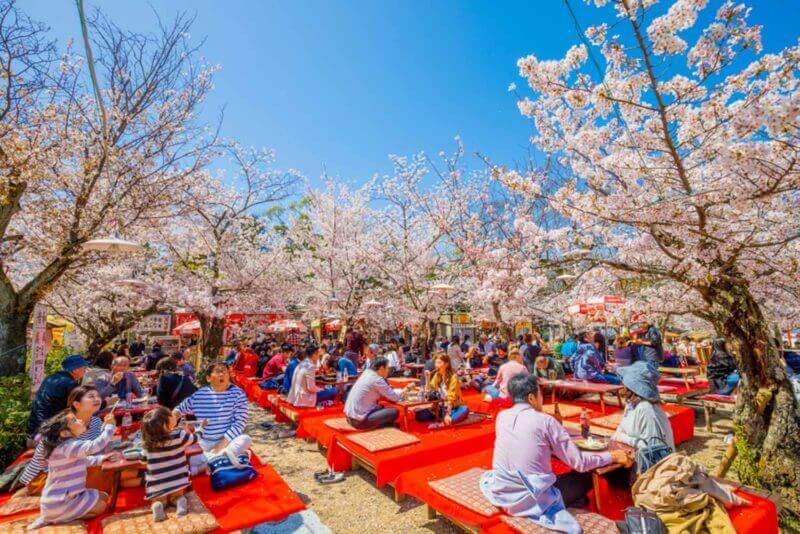
Maruyama Park is a public park next to Yasaka Shrine in the Higashiyama District Kyoto,Japan = shutterstock
Yasaka Jinja Shrine is a traditional shrine most familiar to people in Kyoto. This shrine is located in the eastern part of Kyoto city, it is close to Shijo Kawaramachi which is the busiest downtown in Kyoto. After about 8 minutes on foot from Shijo Kawaramachi, you will arrive at the entrance of Yasaka Jinja Shrine seen in the photo above.
I think that Yasaka Jinja Shrine is a very casual shrine. For example, Kinkakuji and Ginkakuji were the temple of powerful people. In contrast, Yasaka Shrine has been a place where ordinary people frequently visit. I like this casual feeling at Yasaka jinja Shrine.
In the back of the Yasaka jinja Shrine there is Maruyama Park, renowned as a sakura sightseeing spot. So it is crowded with many people on weekends. Tourists who rented kimonos in nearby Gion come to shoot pictures at Yasaka Shrine and Maruyama Park.
Yasaka Jinja Shrine is said to have been built in 656. Every year since the 9th century, “Gion Matsuri Festival” was held as a festival of Yasaka Jinja Shrine every year. This festival is the biggest festival in Kyoto.
>> Please see this article for details of the Gion Matsuri festival
>> Please see this article about the cherry blossoms at Maruyama Park
>>Find the best deal, compare prices, and read what other travelers have to say at Tripadvisor!
Kyoto Must see! ‘Gion’
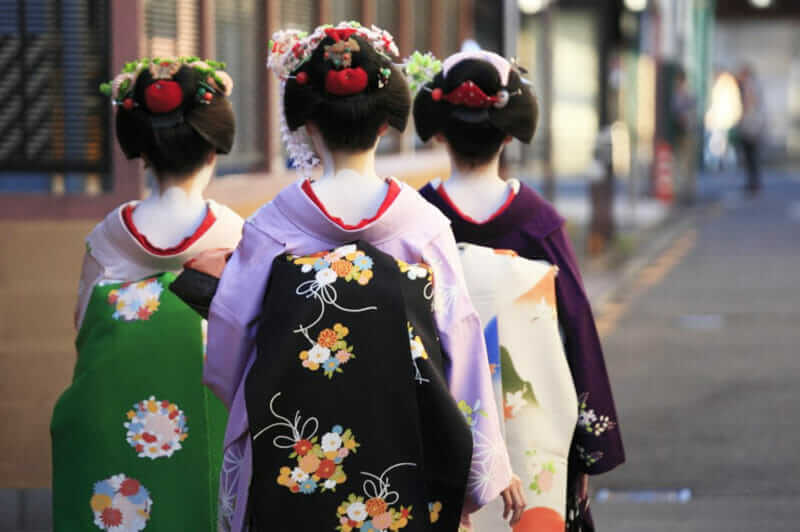
Back view of three geisha going for their appointment at dusk in Kyoto, Japan = shutterstock

Young women wearing traditional Japanese Kimono walk in the street of Gion, Kyoto old town in Japan = shutterstock
Gion is a district spreading to the west side of Yasaka Shrine. Yasaka Shrine was once called “Gion-sha (Gion Shrine)”. For this reason, this area is collectively called “Gion”.
This district is the area where you are most likely to meet the geisha in Japan. Even now in Gion, there are many Japanese restaurants where geishas perform dance and entertain customers. There are also houses where geisha practice dancing and singing. Many of them are traditional wooden buildings called “Kyo-Machiya”. If you walk in Gion, you will be able to experience the old Japanese atmosphere.
In Kyoto, Geisha is generally called “Geiko”. A woman in her teens under training to become a geisha is called “Maiko”. Geiko and Maiko in Gion are walking in ordinary kimonos during the daytime. In the evening, they dress up on their faces with white makeup, head for Japanese restaurants and so on. If you want to see Geiko and Maiko in Gion, you should go in the evening.
Gion spreads on both sides of the main street (Shijyo dori) that continues from Yasaka Shrine to Shijyo Kawaramachi. Many of the traditional Japanese wooden buildings remain in the south area of the main street. On the south side there is a beautiful street called Hanamikozi and it is crowded with tourists. In this street, as in the second picture above, there are also many women who are foreign tourists walking with rental kimono.
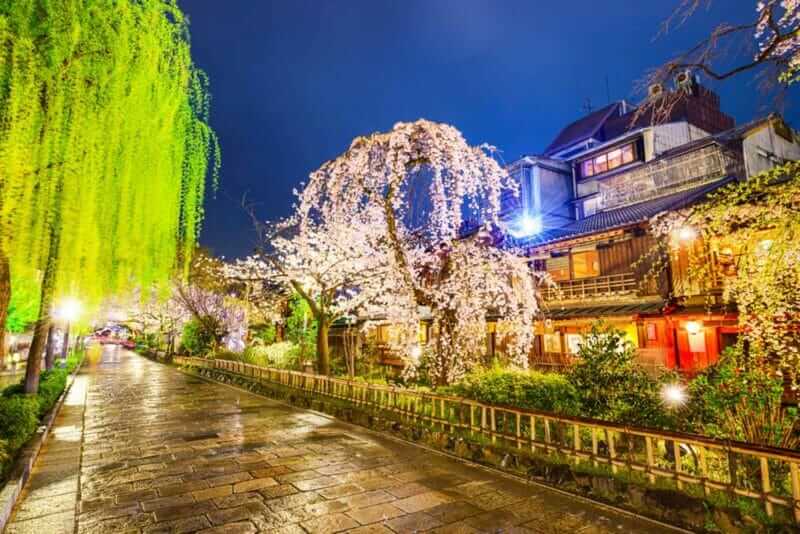
Kyoto, Japan at the historic Gion Shirakawa District during the spring season = shutterstock
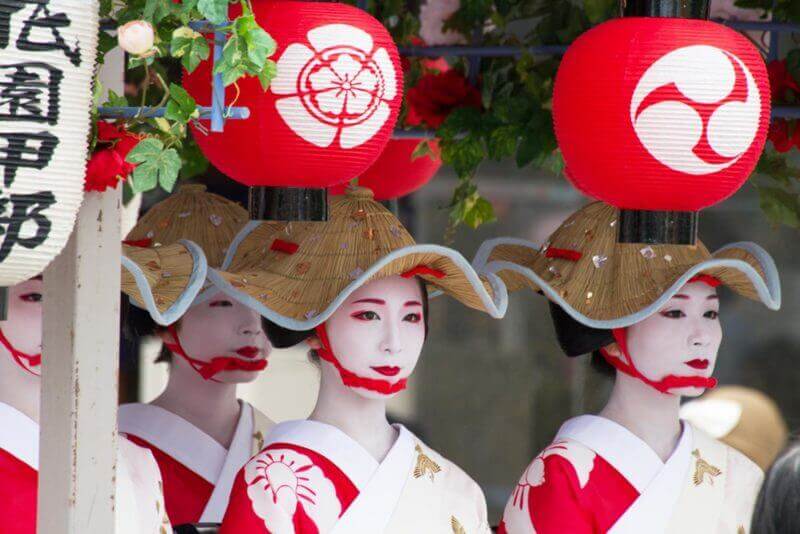
Maiko girl (or Geiko lady) on parade of hanagasa in Gion Matsuri (Festival) held on July 24 2014 in Kyoto, Japan = shutterstock
Also on the northern side of the main street there is a wonderful street called Gion Shirakawa, as seen in the first picture above. The area around this cobblestone trail is beautiful especially in spring when cherry blossoms bloom.
Some people misunderstand that “Geisha are prostitutes”. That is quite different. I have interviewed them before. They are professionals entertaining guests with dancing, singing and so on.
Every year in July, the Gion Mtsuri Festival will be held around Yasaka Shrine. Gion Mtsuri Festival is the most famous festival in Kyoto. This festival is held for about a month. At this time, the area of Gion is lively. As seen in the photo above, Gion’s Geiko and Maiko also appeared in the festival wearing beautiful kimonos.
>> For details about Gion Matsuri Festival, please click here
>> Photos: Traditional Kyoto in Summer
>> Photos: Geisha (Maiko & Geigi) in Gion, Kyoto
>>Find the best deal, compare prices, and read what other travelers have to say at Tripadvisor!
Kyoto Must see! ‘Kamogawa River’
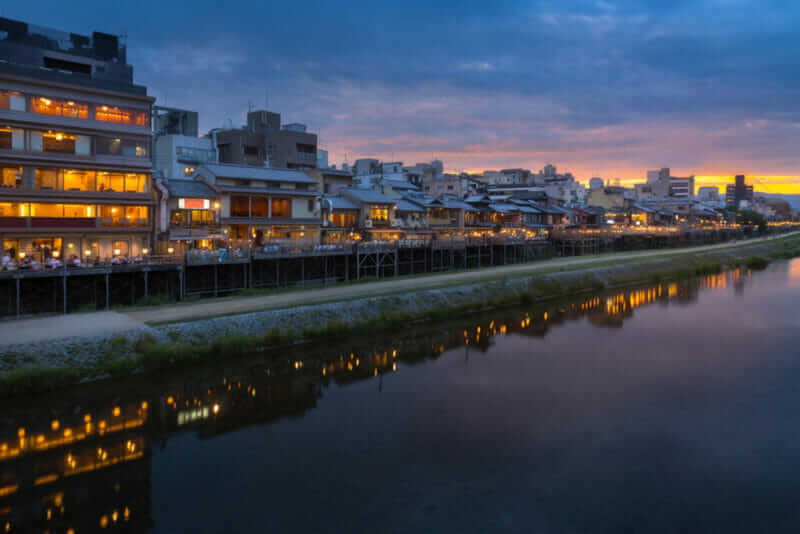
Old house and restaurant in Kamo river or kamogawa river at sunset, Gion, Kyoto, Japan = shutterstock
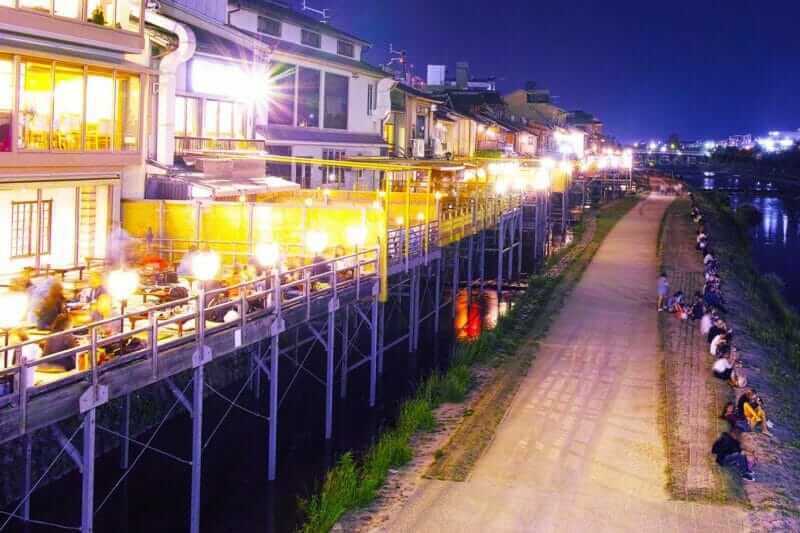
The building on the right is called “Yuka”, the local restaurant seats in a location where the Kamogawa river can be seen outdoors, Kyoto, Japan = AdobeStock
Kamogawa river is a beautiful river that flows from the north to the south in Kyoto city. This river is not so big, but along with the Katsuragawa river that flows in the west, it is very familiar to Kyoto citizens.
There are two points I would like to recommend as the view point of Kamogawa river. First, it is the river side from Kamigamo Jinja shrine to Shimogamo Jinja shrine. In this area, you can enjoy the beautiful nature of Kyoto.
And secondly, it is a river side around Shijo Kawaramachi. There are lots of restaurants in this area. From May to September each year, these restaurants will set up big terraces of wooden structure on the Kamogawa river, as seen in the photo above. In this area, Kamogawa river has a tributary besides the mainstream. Restaurants are to set up terraces on this tributary. These terraces are called “Yuka”. These terraces are on the river so it is cool and you can watch great scenery.
Summer in Kyoto is very hot. So from ancient times people in Kyoto have made various ingenuity in their lives. This “Yuka” is also one of the ingenuity to enjoy the summer. If you travel in Kyoto in the summer, please try experiencing meals at “Yuka” by all means.
>> Photos: Kamogawa River in Kyoto
>>Find the best deal, compare prices, and read what other travelers have to say at Tripadvisor!
Kyoto Must see! ‘Pontocho district’
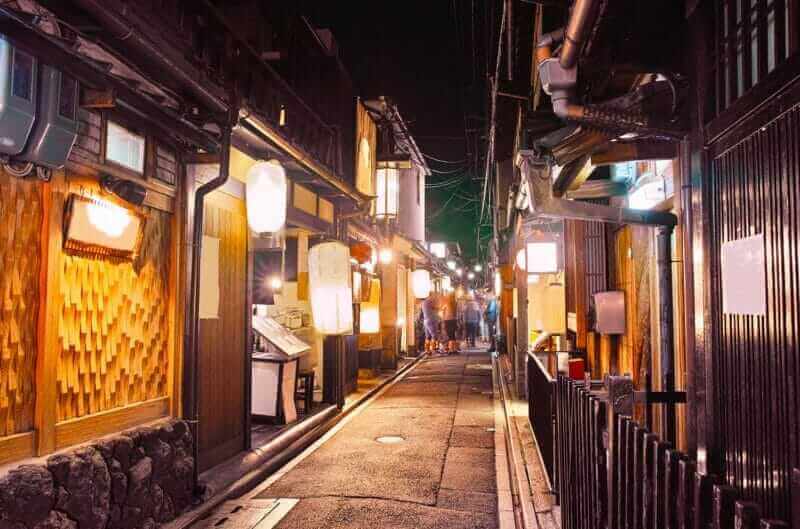
Pontocho district in Kyoto. Pontocho is famous for the preservation of forms of traditional architecture and entertainment = AdobeStock
Pontocho is a small district along the Kamogawa river in the downtown area of Shijo Kawaramachi. Traditional two-storied wooden buildings are lined up on both sides of the cobbled path of about 500 meters north and south. Here are facilities where geishas practice dancing and singing, and Japanese restaurants where geisha entertain customers. Recently, stylish restaurants and pubs for tourists have increased and it is very lively.
Pontocho is very narrow, but this trail has a traditional atmosphere of Kyoto. I recommend walking here.
In restaurants along the Kamogawa river in Ponto-cho, you can enjoy dinner and lunch at the terraces called “Yuka” which I introduced above from May to September. This experience can only be done in Kyoto. Please try it.
>> Click here if you want to know the overview of Pontocho and the tour menu etc.
Kyoto Must see! ‘Nishiki Market’
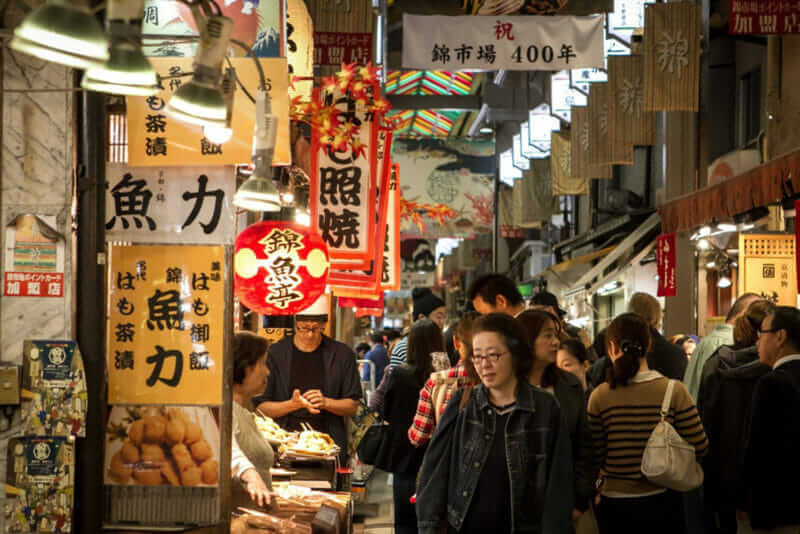
People and tourists flocked into the famous Nishiki Market in Kyoto, Japan = shutterstock

In the Nishiki market, traditional sweets in Kyoto are also sold
Nishiki Market is a shopping district that runs about 400 meters in parallel to the north side of Shijyo-dori, the premier road of Kyoto. The street width of this shopping street is only 3-5 meters. About 130 stores are gathered here. There is a roof in this shopping area so you do not have to worry about getting wet by rain.
In this market, foodstuffs of various genres in Kyoto are sold. It was a place where only Kyoto citizens came before, but now it is a tourist attraction where many tourists come.
The Nishiki market can be said to be a theme park with the theme of Kyoto’s food. If you walk in this shopping area, you can see the vegetables in Kyoto, fruits, fresh fish, traditional sweets, street foods, sake and so on. If you want to eat or drink them, you can purchase it easily and eat and drink on the spot. All the clerks are kind and friendly.
The Nishiki market has a history of about 1300 years. In this area, cold water sprang up, so fishmen gathered to cool the fresh fish. A shopping area was born in the beginning of the 17th century, and has been popularized as being called “Nishiki” by the citizens of Kyoto.
If I mention one disadvantage about this shopping street, the Nishiki market has been very popular recently and there are very many tourists. It really crowded on weekends and holidays. So I recommend you visit relatively free morning and weekday.
>> Click here if you want to know the overview of The Nishiki market and the tour menu etc.
Kyoto Must see! ‘Kodaiji Temple’
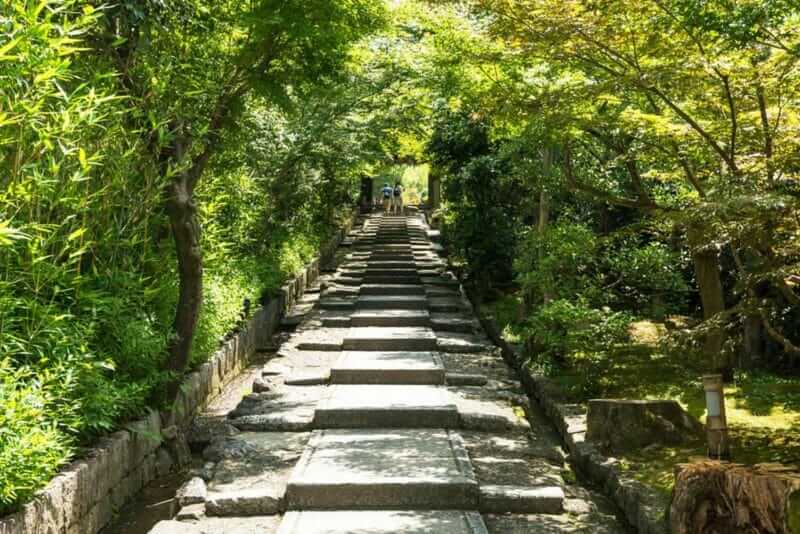
Daidokoro-zaka stone steps that connects Neneno michi street and Kodaiji temple, Kyoto = shutterstock
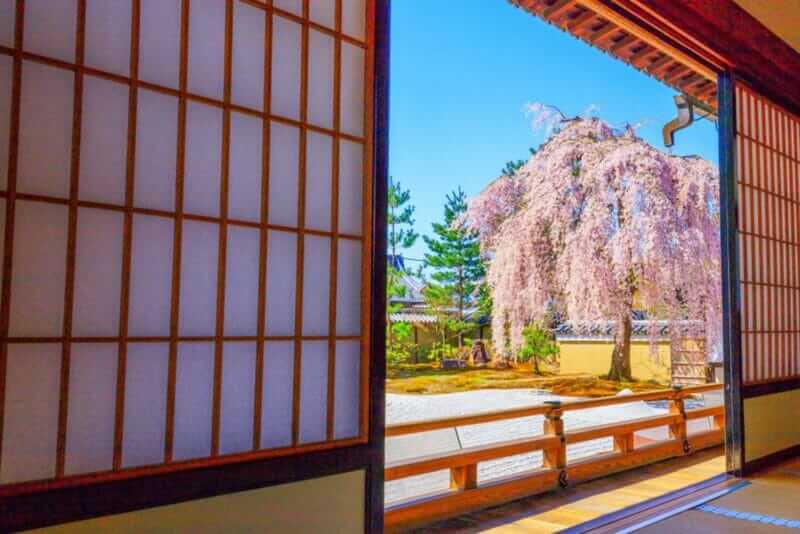
Kodaiji Temple is an outstanding temple in Kyoto Higashiyama District Japan = shutterstock
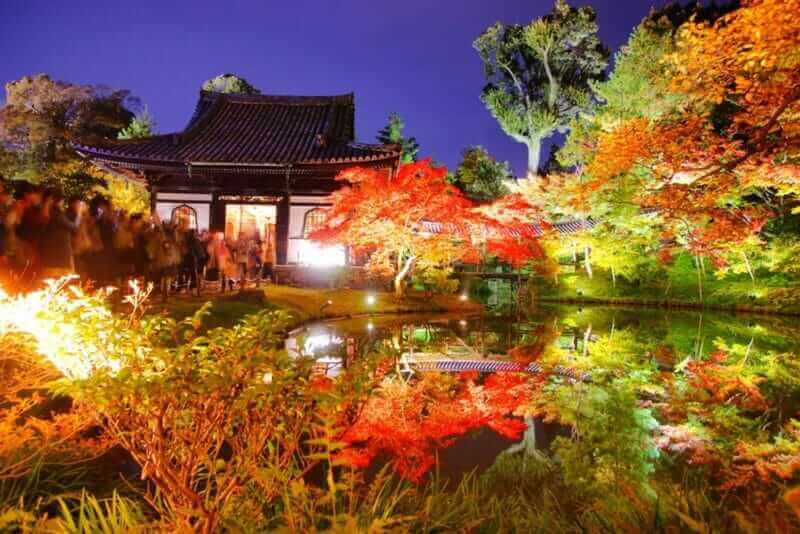
Kaizando Hall is major monuments in Kodaiji Temple. the most beautiful time is the autumn maple leaves illumination during November, Kyoto, Japan = shutterstock
Kodaiji is a big temple located south of Yasaka Shrine. There are famous Kiyomizudera on the south side, so there are many tourists visiting Kodaiji and Kiyomizudera at the same time.
It is officially called Kodaiji-jushozenji Temple. The temple was established in 1606. In commemoration of Hideyoshi TOYOTOMI (1536-1598), a warrior who achieved Japan reunion in the second half of the 16th century, his wife Nene (Kita-no-Mandokoro) built it.
Kodaiji is not well known as compared with Kiyomizudera, Kinkakuji etc. However, those who actually visited this temple are surprised that there are many things to see in this temple.
It is said that there were wooden buildings transferred from the magnificent Fushimi Castle where Hideyoshi lived. Unfortunately, many of them were burned down with several fires. However, the main hall called “Hojo” that was rebuilt afterwards is magnificent, its Zen garden is also wonderful, and there is a splendid cherry tree. Beyond that, old wooden buildings such as Kaizando and Otamaya are scattered. Bamboo forest is also healed. Because Kodaiji is located in the middle of the mountain, you can watch the inside of Kyoto.
At Kodaiji, light performances are often held at night. They are said to have the theme of Buddhism teaching.
Furthermore, Kodaiji is known for its beautiful autumnal leaves. Even during this period light up is done at night. The bright red leaves reflected in the pond are truly brilliant.
To the entrance of Kodaiji Temple, go up the stone steps named “Daidokoro-zaka” from the beautiful road called “Nene no Michi”.
>> Click here if you want to know the overview of Kodaiji Temple and the tour menu etc.
Kyoto Must see! ‘Tofukuji Temple’
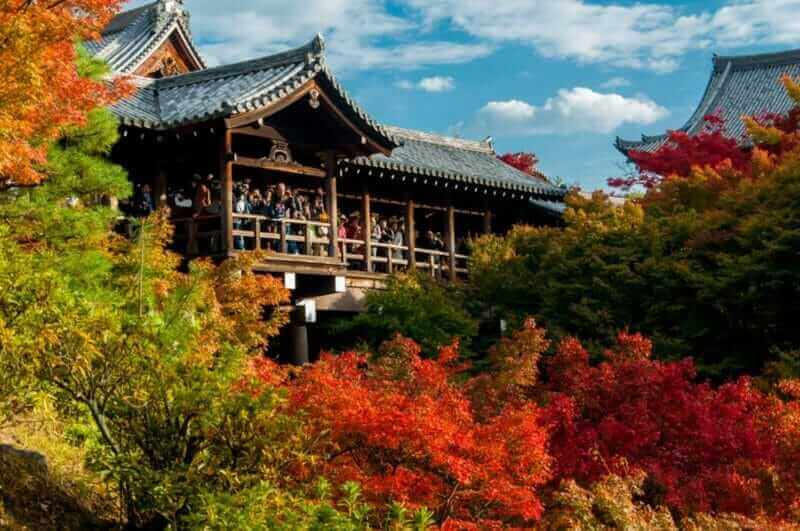
Crowds gather at Tofukuji Temple to celebrate the autumn maple leave festival in Kyoto, Japan = shutterstock
Tofukuji Temple is known as a landmark of autumn leaves. About half of the tourists in this temple are concentrated in November when autumn leaves are beautiful.
In Tofukuji, it is said that there used to be many cherry trees. However, the gorgeous cherry blossoms were judged to hinder monk training and were cut down. Instead, at this temple, maple and others were planted, thus beautifying the autumnal leaves was polished.
Tofukuji located in the southeast of Kyoto city is is the head temple of the Tofukuji School of the Rinzai sect of Zen Buddhism. It was built in 1236.
Tofukuji is known as a landmark of autumn leaves. About half of the tourists in this temple are concentrated in November when autumn leaves are beautiful.
In Tofukuji, it is said that there used to be many cherry trees. However, the gorgeous cherry blossoms were judged to hinder monk training and were cut down. Instead, at this temple, maple and others were planted, thus beautifying the autumnal leaves was polished.
In Tofukuji there are fine wooden bridges called Tsutenkyo, Engetsukyo. From those bridges you can see the trees of this temple garden. From late November to early December every year, you can enjoy splendid autumn leaves.
To Tofukuji is a 10-minute walk from the Tofukuji Temple station on the JR Nara Line and Keihin-hon Line. It is extremely crowded during autumn leaves, so I recommend going in the morning.
>> Click here if you want to know the overview of Tofukuji Temple and the tour menu etc.
Kyoto Must see! ‘Toji Temple’
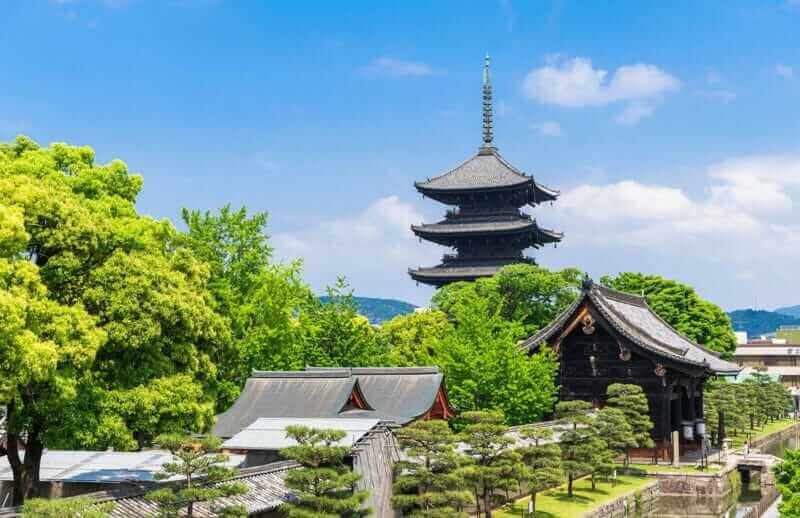
The five-storied pagoda of Toji is one of the landmarks of Kyoto = AdobeStock
Toji Temple is a big temple located 15 minutes on foot from the Hachijoguchi (South Exit) at JR Kyoto Station. It is a 10-minute walk from Toji station on the Kintetsu train.
Toji was built as a temple to protect the east side of Kyoto at the end of the 8th century when Kyoto became the capital of Japan. Toji means “Temple of the East” in Japanese. At that time, the Toji was built on the east side of Kyoto’s main gate (Rashomon), and at the same time Saiji (western temple) was built on the west side. However, Saiji currently does not exist.
Toji has a five-storied pagoda (national treasure) with a height of 54.8 meters. This is the highest in Japan as a wooden tower. This five-storied pagoda is a symbol of Kyoto as it can be seen from JR’s Shinkansen.
Unfortunately this five-storied pagoda was destroyed by fire many times. The current tower is the fifth generation built in 1644.
>> Click here if you want to know the overview of Toji Temple and the tour menu etc.
Kyoto Must see! ‘Byodoin Temple’
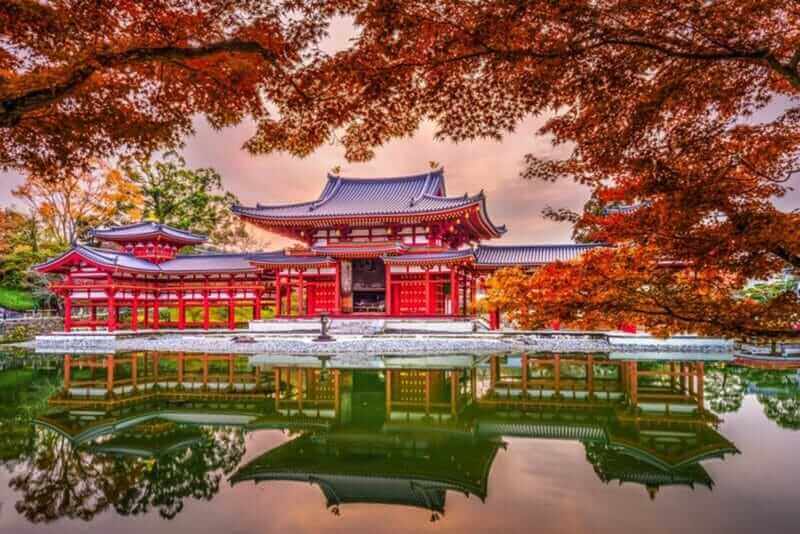
Byodoin temple with red maple leaves in colorful autumn, one of the world heritage and most popular travel place in Japan = shutterstock
Byodoin Temple is a beautiful temple located in Uji City, Kyoto Prefecture, in the south of Kyoto City. This temple was erected in 1052 by Yorimichi FUJIWARA who was the supreme authority. The Fujiwara family had a mighty power at that time. Byodoin Temple is a symbol of the Fujiwara family’s glory.
The most famous in Byodoin is “the Phoenix Hall (Hoodo)” built in 1053, as seen in the picture above. The Phoenix Hall is drawn in Japan’s 10 yen coin.
The Phoenix Hall has a beautiful shape as if Phoenix is spreading its wings. In the vicinity of Byodoin there have been fire many times, but only the Phoenix Hall miraculously escaped the disaster. The Phoenix Hall mirrors its beautiful figure in the pond as it was about 1000 years ago.
>> Click here if you want to know the overview of Byodoin and the tour menu etc.
Kyoto Must see! ‘Daitokuji Temple’

Main gate of Daitokuji, Kyoto city, Japan = shutterstock
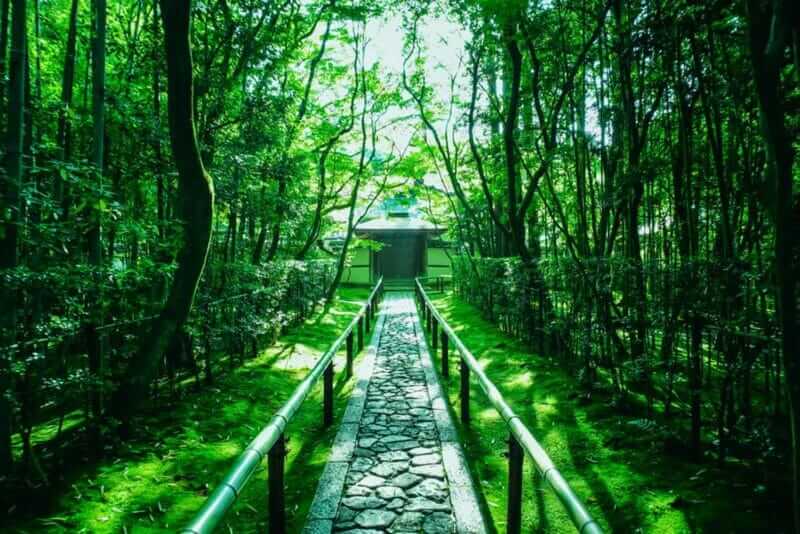
Kotoin Temple of Daitokuji Temple in Kyoto, Japan = shutterstock
Daitokuji is a vast Zen temple of Rinzai sect in the northern part of Kyoto city. It was built in 1325.
There are more than 20 wooden buildings in Daitokuji including the sub temples. Because there are few sub-temples that are open all the time, you can usually walk only. The precincts of Daitokuji are very calm so you can stroll comfortably. In the autumn more cultural properties and gardens will be made public in many sub temple.
The most popular sub temple is Kotoin which is open all the time. Approximately 50 meters of the entrance of this sub temple is wrapped in trees and it has a wonderful atmosphere. In Kotoin, please have a look at the simple Zen Garden, where maple and moss are beautiful.
>> Photos: Daitokuji Temple -The World of Zen in Harmony with Nature
>> Click here if you want to know the overview of Daitokuji Temple and the tour menu etc.
Kyoto Must see! ‘Ryoanji Temple’
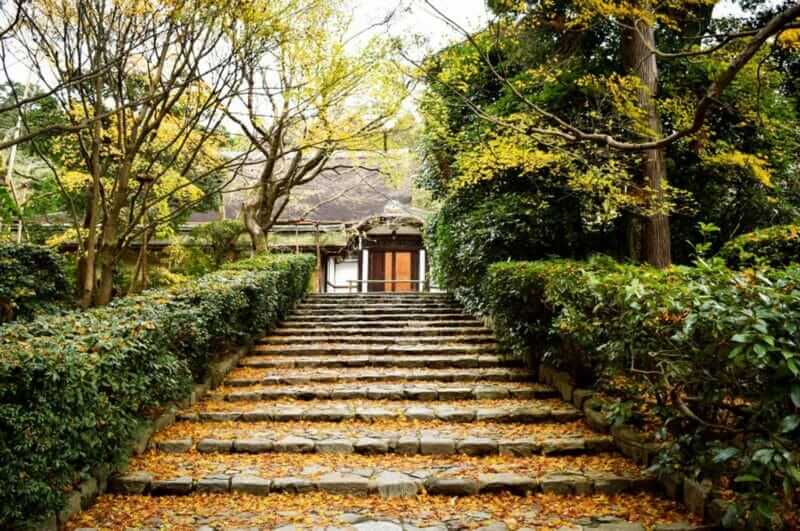
Beautiful stairs to Ryoanji Temple in Autumn , Kyoto, Japan = shutterstock
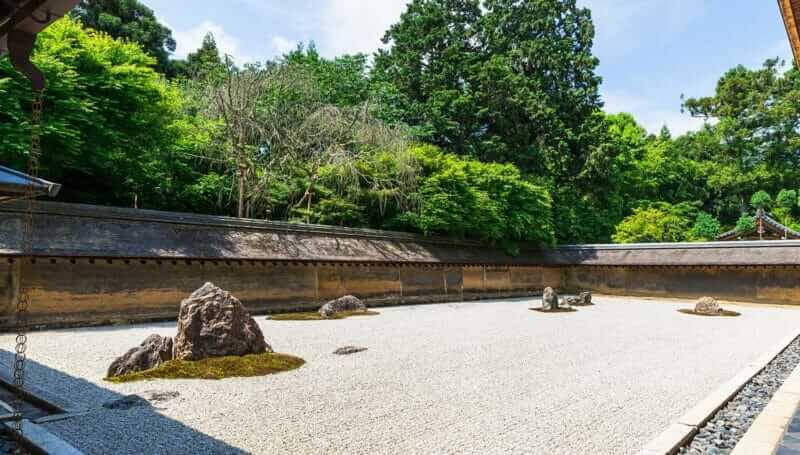
zen stone garden at Ryoanji (Ryoan-ji) Temple. Buddhist zen temple of Rinzai school, Kyoto, Japan = AdobeStock

Japanese tourists enjoy tranquility at Ryoanji Temple in Kyoto, Japan. This Zen Buddhist temple is famous for its rock garden = shutterstock
Ryoanji Temple is a Zen temple located in the northwest of Kyoto City. It is about 1 kilometer west of Kinkakuji temple. This temple is very famous in its Zen garden (Rock garden).
I feel that this garden in Ryoanji Temple is number one among the Zen gardens in Japan. The impact of sitting in front of this Zen garden can not be told to you very much in the photographs. In front of the Zen garden of Ryoanji, you surely feel that miscellaneous thoughts disappear from within your mind.
When Queen Elizabeth of the UK made an official visit to Japan in 1975, she hoped to visit Ryoanji and raped this Zen garden. Please do quietly face this garden by all means.
This Zen garden spreads white sand in a space of 25 meters in width and 10 meters in depth and has 15 large and small stones of 5, 2, 3, 2 and 3 from the east. There is nothing useless here.
Ryoanji is vast and there are beautiful gardens with large ponds on the south side.
>> Click here if you want to know the overview of Ryoanji Temple and the tour menu etc.
Kyoto Must see! ‘Kyoto Imperial Palace (Kyoto Gosho)’
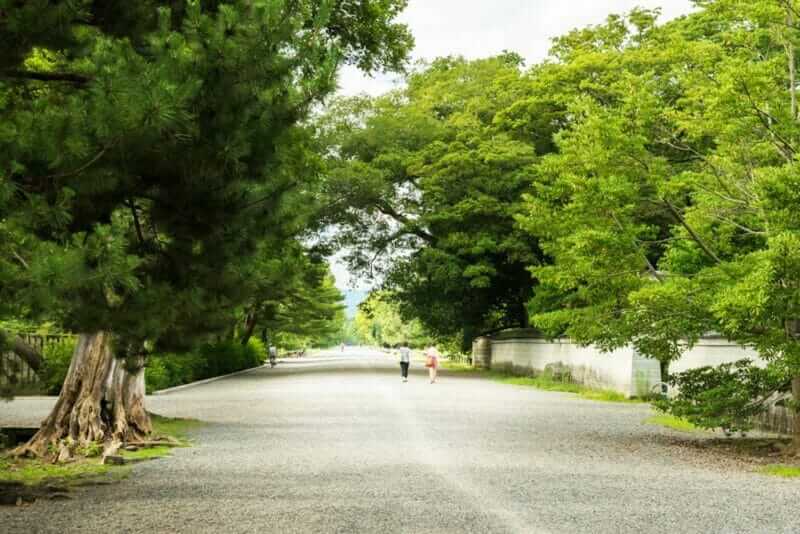
Walkway in Kyoto gosho imperial palace park = shutterstock
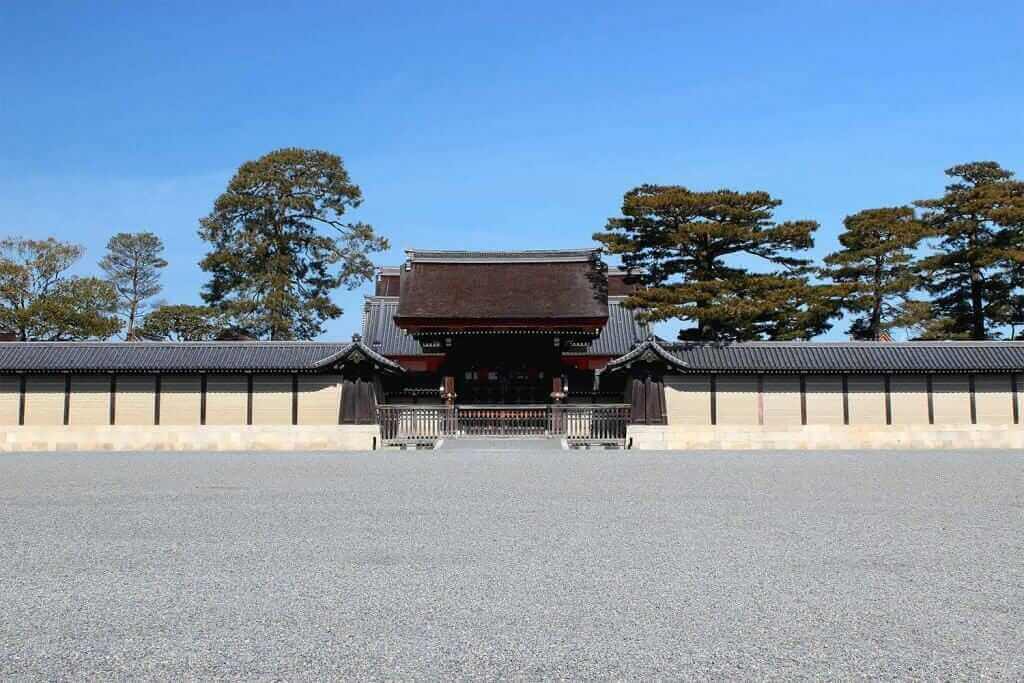
Kyoto Imperial Palace, Kyoto, Japan = Adobe Stock
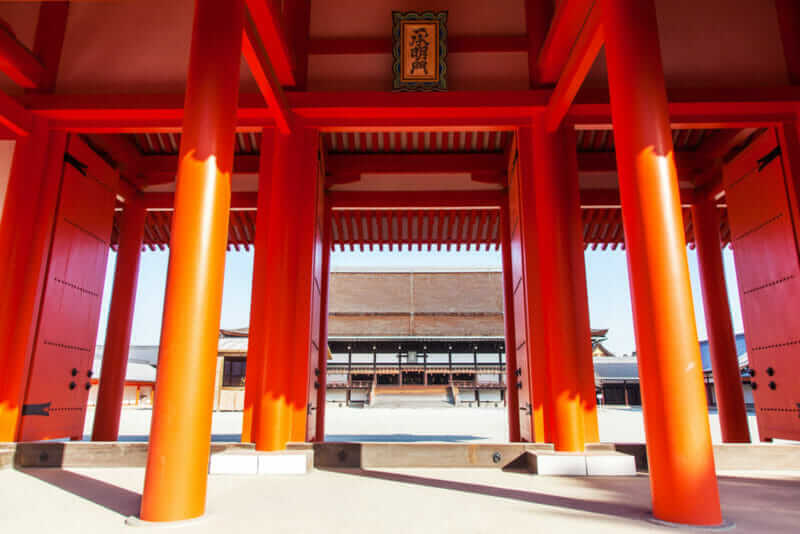
Jomei-mon Gate, Dantei and Shishinden, Kyoto Imperial Palace, Japan = shutterstock
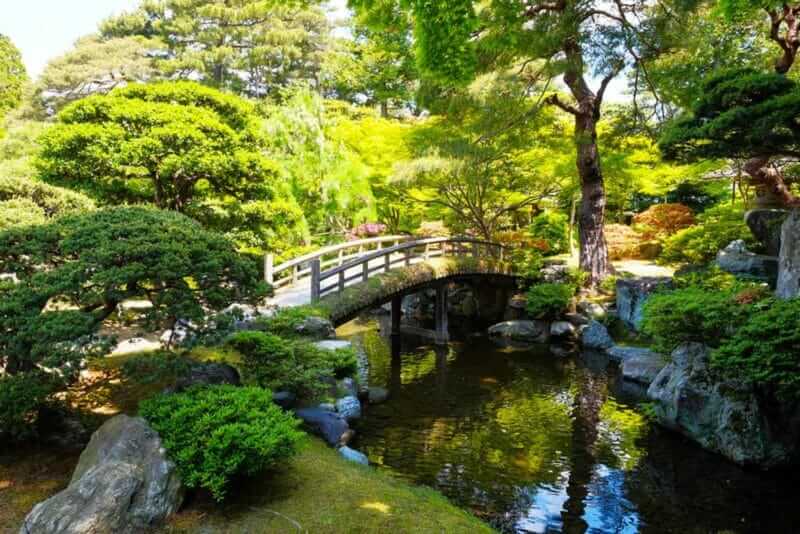
Kyoto Imperial Palace also has a Japanese garden with big pond, Kyoto city, Japan = shutterstock
Kyoto Imperial Palace (Kyoto Gosho) is a place where the emperors of the past lived and worked, from the 14th century until 1869. It is on the north side of Kyoto city center. This palace has recently become publicly available for free throughout the year (except Monday etc). If you go to this palace, you can feel the court culture in Japan closely.
The nearest station of Kyoto Imperial Palace is the Imadegawa Subway Station on the Karasuma Line. After walking about 5 minutes from this station, you will arrive at a vast area (the first photo above) surrounded by beautiful walls. This is a park surrounding the Kyoto Imperial Palace. A lot of the nobility’s mansions were in line here before. After walking for about 5 minutes in this park, you will arrive at “Seishomon Gate” at Kyoto Imperial Palace. Let’s go to the Palace after taking the baggage check here.
The site of Kyoto Imperial Palace is about 250 meters east-west and about 450 meters north and south. The four sides are surrounded by beautiful walls, and there are six gates in total, including Seishomon Gate.
After going through the Seishomon Gate, you can look around the elegant courtyards in Japan. Unfortunately the wooden buildings of Kyoto Imperial Palace have suffered fire many times and have burned down. Many of the buildings you can see now are built in the era of the Tokugawa shogunate, but they are all the best buildings in Japan.
In the 3rd photo above, a huge building visible in the back of the red gate is the main hall “Shishinden”. Here, the most important ceremonies are held. In the northwest of Shishinden, there is a “Seiryoden” where the Emperor did the office. Besides this, you can see several large wooden buildings and Japanese gardens.
Kyoto was the capital of Japan from 794 to 1869. In the city of Kyoto, ordered streets were set up in the north-south and east-west, the main gate was built at the southern end of the city, the Kyoto Imperial Palace was built a little north of the city. Actually the place of the Palace has changed several times. In the 14th century, Kyoto Imperial Palace settled in its present place.
Kyoto Imperial Palace is very expansive including the surrounding parks, so please be careful not to get lost in the way. If you make a mistake in the direction, you have to walk for a very long time. Especially in the hot summer, it is very tight. For details of Kyoto Imperial Palace, please visit the official website.
>> Photos: Kyoto Imperial Palace (Kyoto Gosho)
>> Click here if you want to know the overview of Ryoanji Temple and the tour menu etc.
Kyoto Must see! ‘Nijo Catsle’
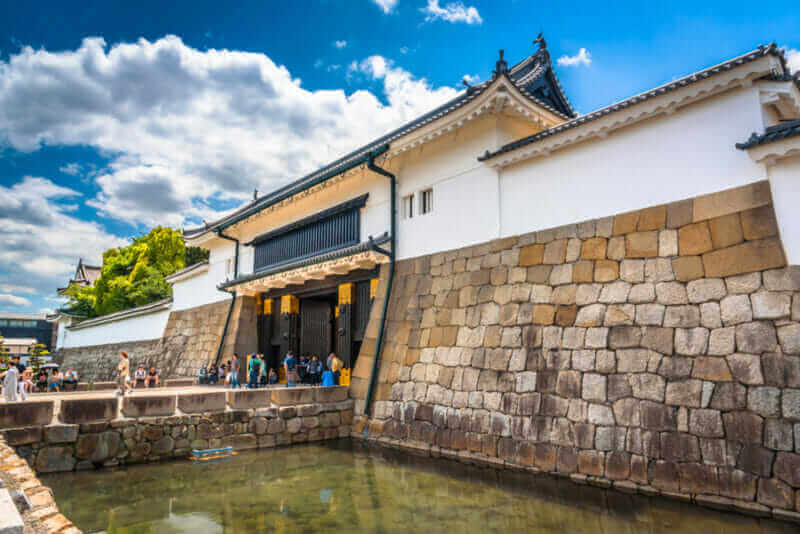
Nijo Castle = in Kyoto, Japan = shutterstock
Nijo Castle is the only castle in Kyoto city. While many sightseeing spots in Kyoto city are shrines and temples, Nijo Castle is a highly original tourist attraction. If you add Nijo Castle to your itinerary in Kyoto, you will be able to enjoy a varied trip.
Nijo Castle was built as a base in Kyoto by the Tokugawa shogunate in the 17th century. The executives of the Tokugawa shogunate met the nobles and the lords in this castle. So in Nijo castle, wonderful wooden buildings were built to show off the authority of the Tokugawa shogunate, and luxurious paintings were also set up in the buildings.
When the Tokugawa shogunate was destroyed in the 19th century, in this castle the last Tokugawa Shogun Yoshinobu TOKUGAWA gathered lords and opened a historic meeting. If you go to this castle, you will be able to enjoy including such Japanese history.
>> For details on Nijo Castle, please click here
>> Click here if you want to know the overview of Nijo Castl and the tour menu etc.
Kyoto Must see! ‘Katsura Rikyu’
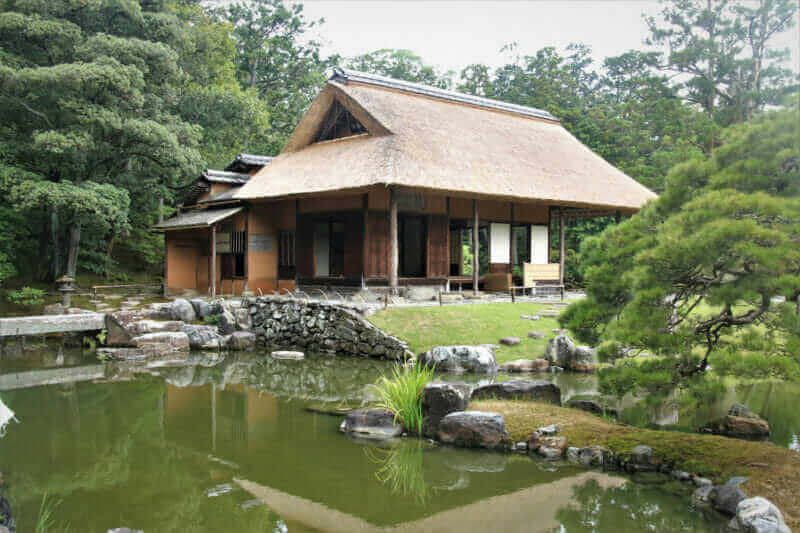
Katsura Rikyu in Kyoto
Katsura Rikyu is a wonderful Japanese garden that represents Japan. It was built as a villa by the Royal family in the 17th century. At this time, amazing gardens were built.
Once in Kyoto, it is said that royal families and aristocrats produced a number of fine Japanese gardens. Many of them no longer exist. Under such circumstances, Katsura Rikyu is maintaining the traditional garden almost completely and it is very rare.
Currently the Katsura Rikyu is managed by the Imperial Household Agency and you need to book in advance in order to get inside. Although it takes time and effort in advance reservation, I think that Katsura Rikyu is still a tourist attraction worth visiting.
>> For details on Katsura rikyu, please click here
>> Click here if you want to know the overview of Katsura Rikyu and the tour menu etc.
Kyoto Must see! ‘Arashiyama’
Arashiyama is one of the most popular tourist destinations in Kyoto. It is located in the northwest part of Kyoto city.
To be accurate, Arashiyama is the name of the mountain (altitude 381.5 meters) seen in the picture below. This mountain has wonderful cherry blossoms in spring. After that, fresh green shines. Autumn leaves are beautiful in the fall. Once, loving this mountain, the nobles built villas in this area. Thus, this area became famous, and now this area is collectively called “Arashiyama”.
There is a beautiful river called Katsuragawa and there are many attractive sightseeing spots around the river.
Arashiyama tends to cause traffic congestion. So I recommend you to get off at Arashiyama station by using Hankyu Railway or Keihoku Electric Railway.
There is also Saga-Arashiyama station on the JR Sanin Main Line, about a 15-minute walk from the center of Arashiyama. If you are going to sightsee from Kyoto station, it will be convenient to go by JR train.
Togetsukyo Bridge
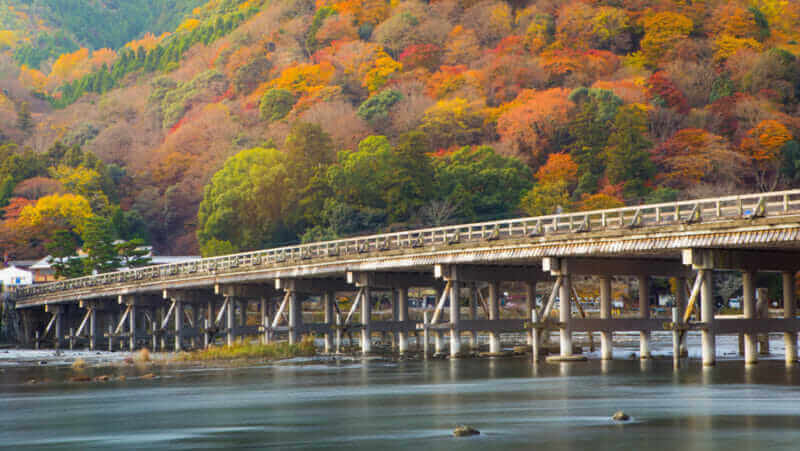
Togetsukyo is a 155-meter bridge over the Katsura River flowing leisurely in Saga Arashiyama in Autumn, Kyoto, japan = shutterstock
Togetsukyo Bridge is a beautiful bridge over the Katsuragawa. The scenery of Togetsukyo Bridge with Arashiyama Mountain backdrop is often posted in sightseeing guide books and so on. Even just looking at this scenery quietly by the river will heal your mind.
This bridge has been washed away many times by the flood and has been rebuilt every time. The current Togetsukyo bridge was built in 1934. Although not well known, the current Togetsukyo bridge is made of reinforced concrete, not wooden. In order not to hurt the landscape, only the railings are built with beautiful wooden.
Souvenir shops and restaurants are lined up around this bridge. Let’s visit various sightseeing spots in the Arashiyama area from here.
>>Find the best deal, compare prices, and read what other travelers have to say at Tripadvisor!
Hozugawa River
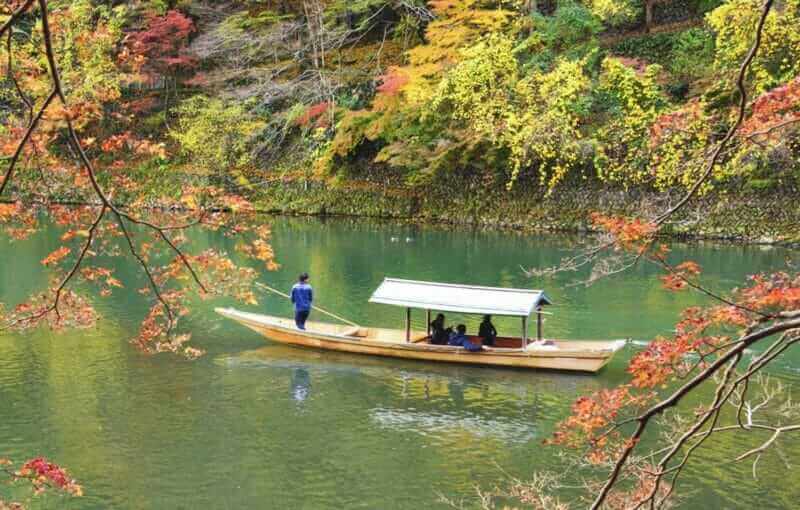
Tourist Boat in Autumn at Hozugawa River, Arashiyama, Kyoto, Japan = shutterstock
The part upstream from Arashiyama in Katsuragawa is called Hozugawa River. In the past, timber was being transported from the upstream mountains to Kyoto city using the Hozugawa River. Today, boats are running for tourists as seen in the above picture.
This boat goes down a section of about 16 km from the platform near JR Kameoka station upstream to Arashiyama. The journey takes approximately 90 minutes. You can enjoy the nature around the river and the flow of the Japanese river.
>>Find the best deal, compare prices, and read what other travelers have to say at Tripadvisor!
To JR Kameoka station, you should use the JR San-in main line. The journey time from Kyoto Station is about 30 minutes by taking a local train stop.
A sightseeing train called The Sagano Romantic train (Torokko Ressha) is operated and it is very popular. It is also a good idea to go to Kameoka station by using this sightseeing train.
>>Find the best deal, compare prices, and read what other travelers have to say at Tripadvisor!
Bamboo forest
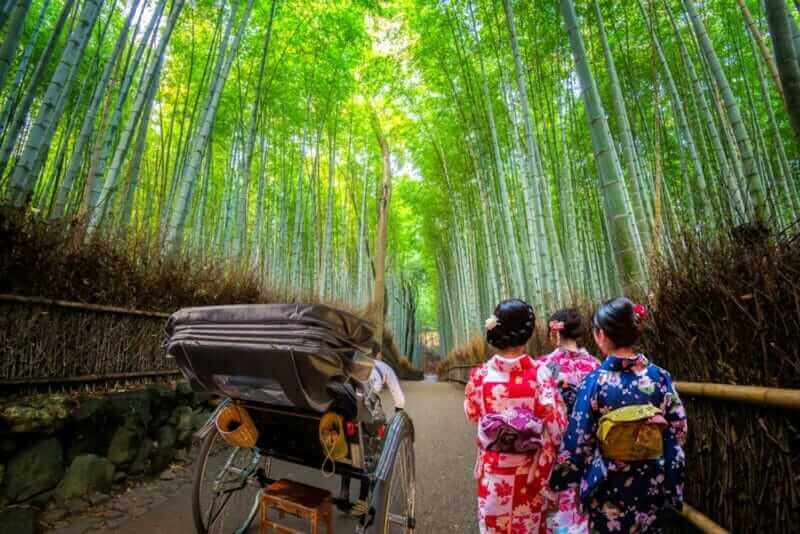
Young women wearing traditional Japanese Kimono and Rickshaw for sightseeing at Bamboo forest of Arashiyama, Arashiyama is a district on the western outskirts of Kyoto, Japan = shutterstock
About tens of thousands of bamboo trees are spreading in the Sagano district located on the northern side of Togetsukyo Bridge. There is a trail in this bamboo forest, and this trail is very popular among tourists. Bamboo forests are located about 5 minutes on foot from Arashiyama station of Keihoku Electric Railway.
In this bamboo forest, you can take a very beautiful picture. Many people take rental kimonos and take pictures. Some people ride a tourist rickshaw and take a video here. However, since this bamboo forest gets crowded, I recommend you go early in the morning if you want to take a really nice picture.
>>Find the best deal, compare prices, and read what other travelers have to say at Tripadvisor!
Tenryuji Temple
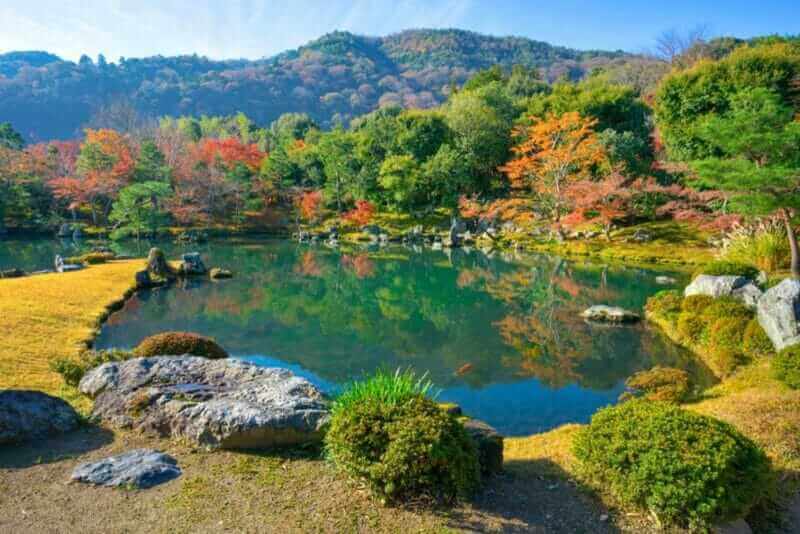
Sogen Pond Garden in Tenryuji Temple.Tenryuji Temple located in Kyoto’s Arashiyama district.Tenryuji Temple is Zen temple = shutterstock
Tenryuji is a large Zen temple located about 5 minutes on foot from the center of Arashiyama. This temple is famous for gardens against the backdrop of beautiful mountains, as seen in the photo above. It is almost impossible for the temples in the center of Kyoto city to backdrop to such beautiful mountains.
Tenryuji once used to be the number one Zen temple in Kyoto. However, most wooden buildings were destroyed by fire many times. The site which was very large was also shrunk. Most of the current large wooden buildings were rebuilt in the 20th century.
However, the garden of this temple, located in Arashiyama, still attracts many people. In November it gets crowded with tourists who see the autumn leaves. So I recommend you go in the morning.
>> Click here if you want to know the overview of Arashiyama and the tour menu etc.
Kyoto Must see! ‘Toei Kyoto Studio Park’
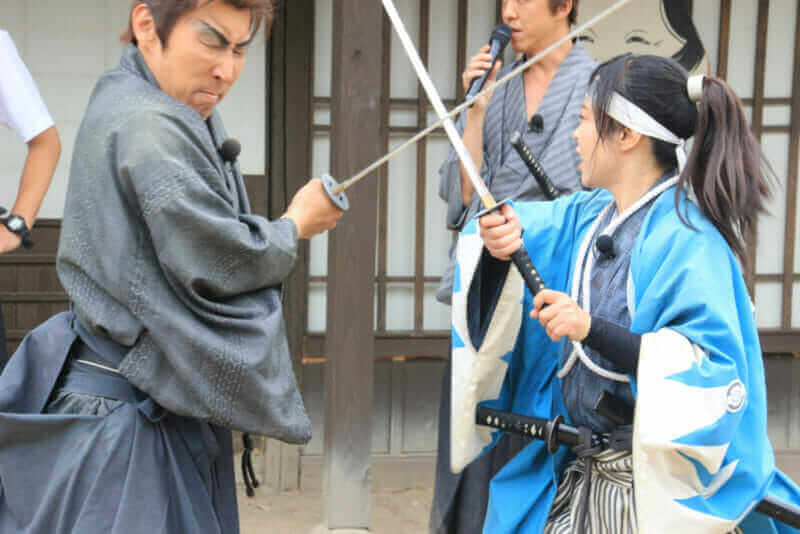
The Toei movie village in Kyoto ,Uzumasa.The demonstration which shows a duel between the samurais with a sword = shutterstock
Toei Kyoto Studio Park is a theme park operated by a film production company Toei. In this theme park, the streets of Japanese old age are reproduced, you can walk in it.
Among the streets, actors who are dressed as samurai and ninja are walking and sometimes holding a show. You can also impersonate as samurai, ninja and so on.
The cityscape in this theme park is full-fledged to be used for filming movies and dramas that Samurai and ninja appear. If you are interested in samurai and ninja, Toei Kyoto Studio Park will surely be a pleasant memory.
If you travel with children, I recommend that you go to Toei Kyoto Studio Park. I also went to this theme park when I first went to Kyoto with my family. My children said that the most enjoyable thing in Kyoto was this theme park!
>> For details on Toei Kyoto Studio Park, please click here
>> Click here if you want to know the overview of Toei Kyoto Studio Park and the tour menu etc.
Kyoto Must see! ‘Kifune Shrine’
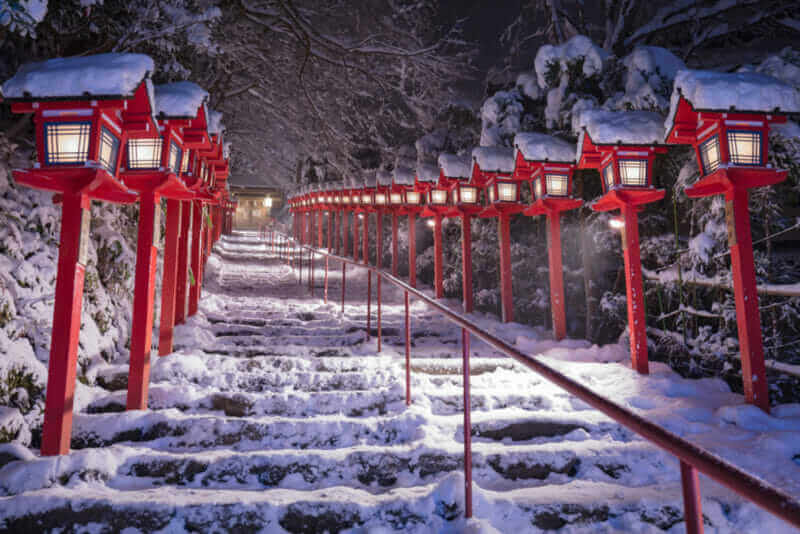
Stone stair and traditional light pole with snow fall in winter at Kifune shrine , Kyoto prefecture , Japan = shutterstock
If you travel in Kyoto in winter, you may want to see snow scenic shrines or temples. It is not snowing much in Kyoto now due to global warming. However, if you go to Kibune shrine, you may be able to shoot a beautiful shrine covered with snow as seen in the picture above.
Kibune is located in the mountain area about 20 km north of JR Kyoto Station. It is cooler in summer than in the center of Kyoto city, and colder in winter. If you go to Kibune, you will be able to enjoy the traditional Japanese landscape in rich nature.
Kibune shrine is also known for beautiful autumn leaves. However, please be aware that it will be very crowded in November.
I wrote an article introducing Kibune as a recommended spot for hiking.
>> For details on Kifune, please click here
>> Photos: Kifune, Kurama, Ohara in winter -Strolling around northern Kyoto
>>Find the best deal, compare prices, and read what other travelers have to say at Tripadvisor!
Thank you for reading to the end.
If you are looking for a Japan tour visiting Kyoto, please click here.
Now, let’s plan to make your vacation in Japan the best experience ever!
